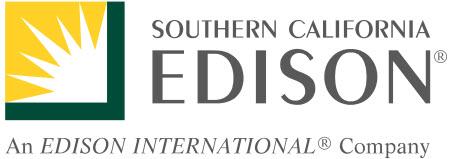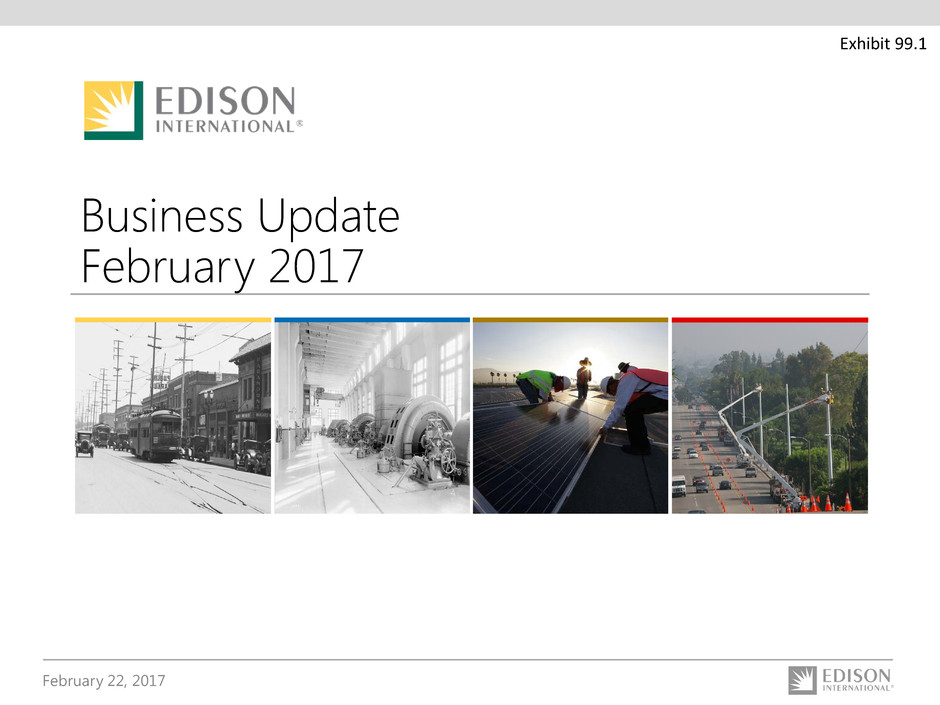
February 22, 2017
Business Update
February 2017
Exhibit 99.1
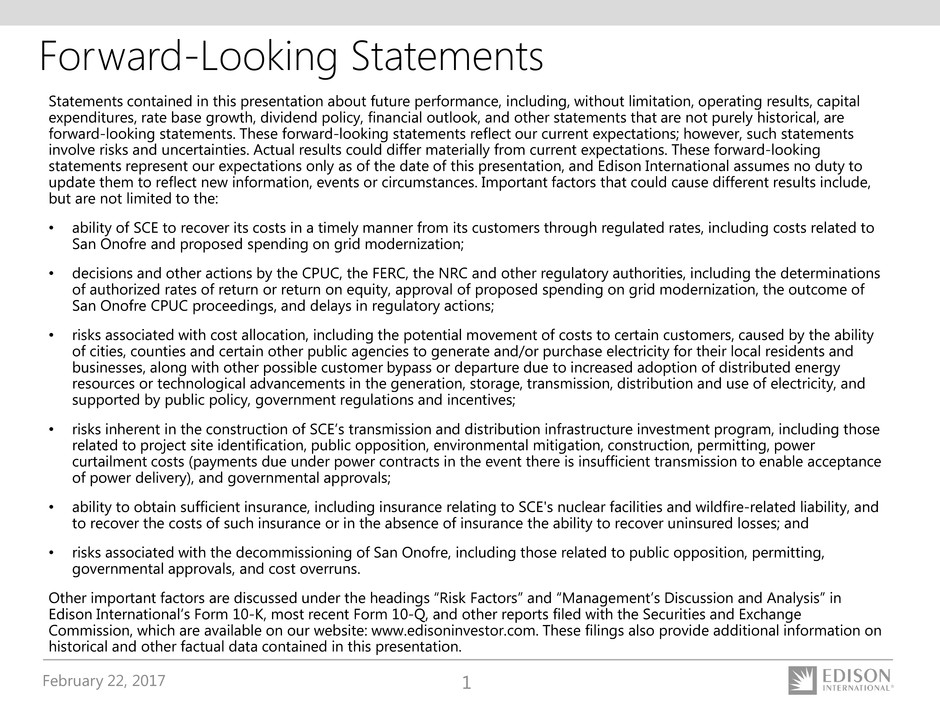
February 22, 2017 1
Statements contained in this presentation about future performance, including, without limitation, operating results, capital
expenditures, rate base growth, dividend policy, financial outlook, and other statements that are not purely historical, are
forward-looking statements. These forward-looking statements reflect our current expectations; however, such statements
involve risks and uncertainties. Actual results could differ materially from current expectations. These forward-looking
statements represent our expectations only as of the date of this presentation, and Edison International assumes no duty to
update them to reflect new information, events or circumstances. Important factors that could cause different results include,
but are not limited to the:
• ability of SCE to recover its costs in a timely manner from its customers through regulated rates, including costs related to
San Onofre and proposed spending on grid modernization;
• decisions and other actions by the CPUC, the FERC, the NRC and other regulatory authorities, including the determinations
of authorized rates of return or return on equity, approval of proposed spending on grid modernization, the outcome of
San Onofre CPUC proceedings, and delays in regulatory actions;
• risks associated with cost allocation, including the potential movement of costs to certain customers, caused by the ability
of cities, counties and certain other public agencies to generate and/or purchase electricity for their local residents and
businesses, along with other possible customer bypass or departure due to increased adoption of distributed energy
resources or technological advancements in the generation, storage, transmission, distribution and use of electricity, and
supported by public policy, government regulations and incentives;
• risks inherent in the construction of SCE’s transmission and distribution infrastructure investment program, including those
related to project site identification, public opposition, environmental mitigation, construction, permitting, power
curtailment costs (payments due under power contracts in the event there is insufficient transmission to enable acceptance
of power delivery), and governmental approvals;
• ability to obtain sufficient insurance, including insurance relating to SCE's nuclear facilities and wildfire-related liability, and
to recover the costs of such insurance or in the absence of insurance the ability to recover uninsured losses; and
• risks associated with the decommissioning of San Onofre, including those related to public opposition, permitting,
governmental approvals, and cost overruns.
Other important factors are discussed under the headings “Risk Factors” and “Management’s Discussion and Analysis” in
Edison International’s Form 10-K, most recent Form 10-Q, and other reports filed with the Securities and Exchange
Commission, which are available on our website: www.edisoninvestor.com. These filings also provide additional information on
historical and other factual data contained in this presentation.
Forward-Looking Statements
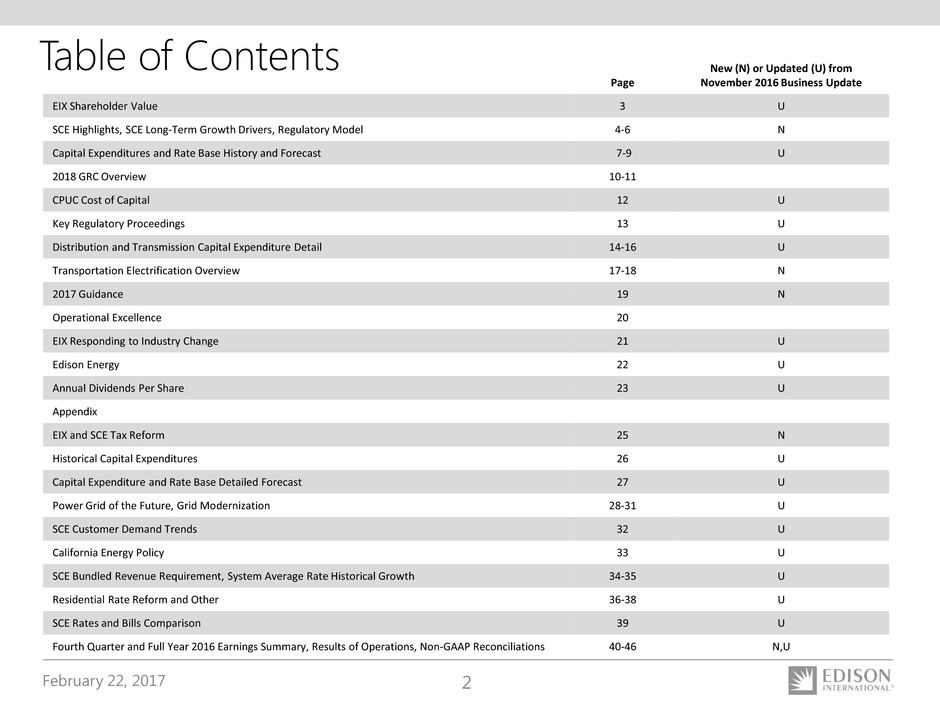
February 22, 2017 2
Page
New (N) or Updated (U) from
November 2016 Business Update
EIX Shareholder Value 3 U
SCE Highlights, SCE Long-Term Growth Drivers, Regulatory Model 4-6 N
Capital Expenditures and Rate Base History and Forecast 7-9 U
2018 GRC Overview 10-11
CPUC Cost of Capital 12 U
Key Regulatory Proceedings 13 U
Distribution and Transmission Capital Expenditure Detail 14-16 U
Transportation Electrification Overview 17-18 N
2017 Guidance 19 N
Operational Excellence 20
EIX Responding to Industry Change 21 U
Edison Energy 22 U
Annual Dividends Per Share 23 U
Appendix
EIX and SCE Tax Reform 25 N
Historical Capital Expenditures 26 U
Capital Expenditure and Rate Base Detailed Forecast 27 U
Power Grid of the Future, Grid Modernization 28-31 U
SCE Customer Demand Trends 32 U
California Energy Policy 33 U
SCE Bundled Revenue Requirement, System Average Rate Historical Growth 34-35 U
Residential Rate Reform and Other 36-38 U
SCE Rates and Bills Comparison 39 U
Fourth Quarter and Full Year 2016 Earnings Summary, Results of Operations, Non-GAAP Reconciliations 40-46 N,U
Table of Contents
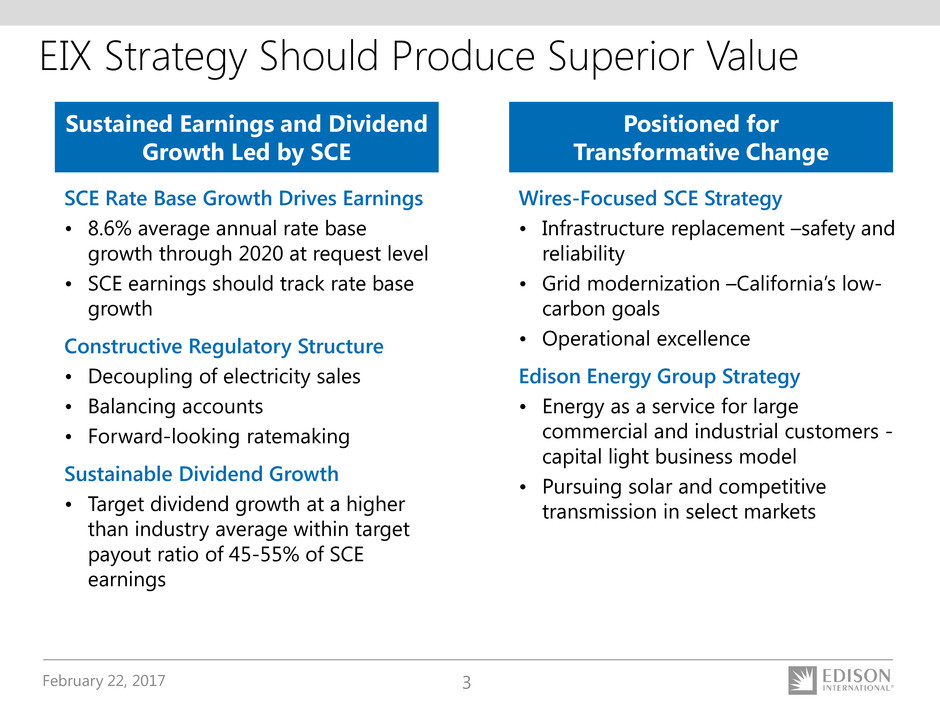
February 22, 2017 3
EIX Strategy Should Produce Superior Value
Sustained Earnings and Dividend
Growth Led by SCE
Positioned for
Transformative Change
SCE Rate Base Growth Drives Earnings
• 8.6% average annual rate base
growth through 2020 at request level
• SCE earnings should track rate base
growth
Constructive Regulatory Structure
• Decoupling of electricity sales
• Balancing accounts
• Forward-looking ratemaking
Sustainable Dividend Growth
• Target dividend growth at a higher
than industry average within target
payout ratio of 45-55% of SCE
earnings
Wires-Focused SCE Strategy
• Infrastructure replacement –safety and
reliability
• Grid modernization –California’s low-
carbon goals
• Operational excellence
Edison Energy Group Strategy
• Energy as a service for large
commercial and industrial customers -
capital light business model
• Pursuing solar and competitive
transmission in select markets

February 22, 2017 4
One of the nation’s largest electric utilities
• 15 million residents in service territory
• 5 million customer accounts
• 50,000 square-mile service area
Significant infrastructure investment
• 1.4 million power poles
• 725,000 transformers
• 103,000 miles of distribution and transmission lines
• 3,100 MW owned generation
Above average rate base growth driven by
• Safety and reliability
• California’s low-carbon objectives
Grid modernization
Electric vehicle charging
Energy storage
Transportation electrification (proposed)
Limited Generation Exposure
• Own less than 20% of its power generation
• Future needs via competitive solicitations
SCE Highlights
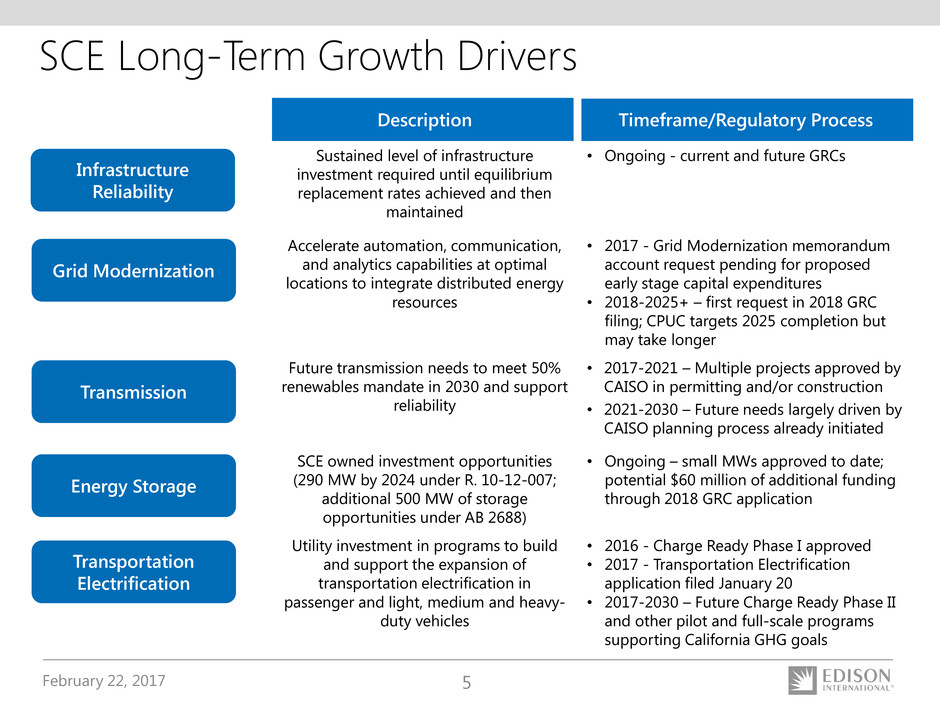
February 22, 2017 5
SCE Long-Term Growth Drivers
Description Timeframe/Regulatory Process
Sustained level of infrastructure
investment required until equilibrium
replacement rates achieved and then
maintained
• Ongoing - current and future GRCs
Accelerate automation, communication,
and analytics capabilities at optimal
locations to integrate distributed energy
resources
• 2017 - Grid Modernization memorandum
account request pending for proposed
early stage capital expenditures
• 2018-2025+ – first request in 2018 GRC
filing; CPUC targets 2025 completion but
may take longer
Future transmission needs to meet 50%
renewables mandate in 2030 and support
reliability
• 2017-2021 – Multiple projects approved by
CAISO in permitting and/or construction
• 2021-2030 – Future needs largely driven by
CAISO planning process already initiated
SCE owned investment opportunities
(290 MW by 2024 under R. 10-12-007;
additional 500 MW of storage
opportunities under AB 2688)
• Ongoing – small MWs approved to date;
potential $60 million of additional funding
through 2018 GRC application
Utility investment in programs to build
and support the expansion of
transportation electrification in
passenger and light, medium and heavy-
duty vehicles
• 2016 - Charge Ready Phase I approved
• 2017 - Transportation Electrification
application filed January 20
• 2017-2030 – Future Charge Ready Phase II
and other pilot and full-scale programs
supporting California GHG goals
Infrastructure
Reliability
Grid Modernization
Transportation
Electrification
Energy Storage
Transmission
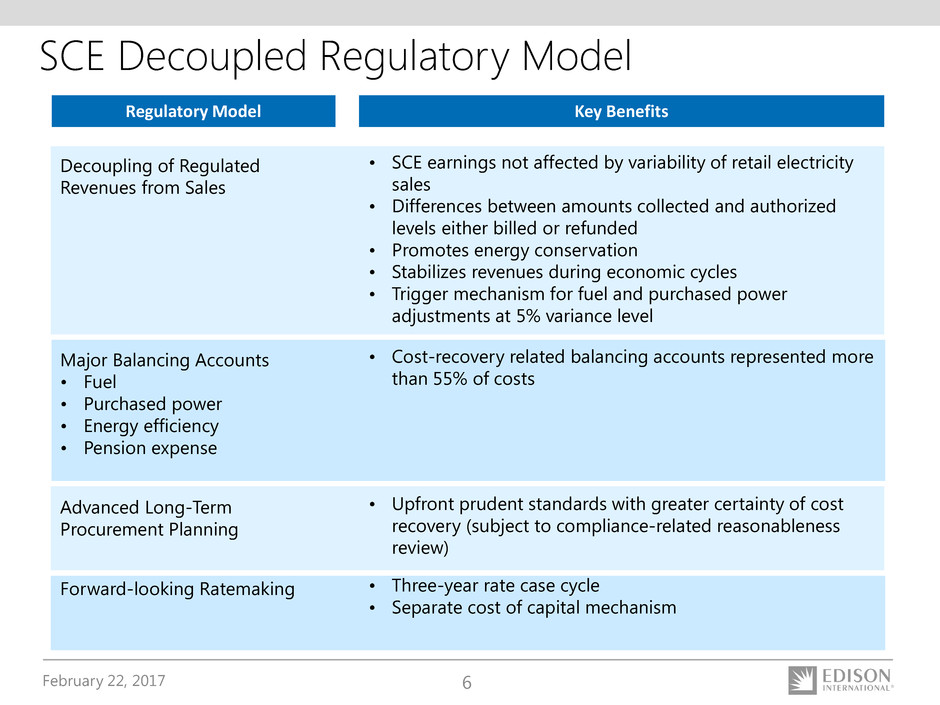
February 22, 2017 6
SCE Decoupled Regulatory Model
Decoupling of Regulated
Revenues from Sales
Major Balancing Accounts
• Fuel
• Purchased power
• Energy efficiency
• Pension expense
Advanced Long-Term
Procurement Planning
Forward-looking Ratemaking
• SCE earnings not affected by variability of retail electricity
sales
• Differences between amounts collected and authorized
levels either billed or refunded
• Promotes energy conservation
• Stabilizes revenues during economic cycles
• Trigger mechanism for fuel and purchased power
adjustments at 5% variance level
• Cost-recovery related balancing accounts represented more
than 55% of costs
• Upfront prudent standards with greater certainty of cost
recovery (subject to compliance-related reasonableness
review)
• Three-year rate case cycle
• Separate cost of capital mechanism
Regulatory Model Key Benefits
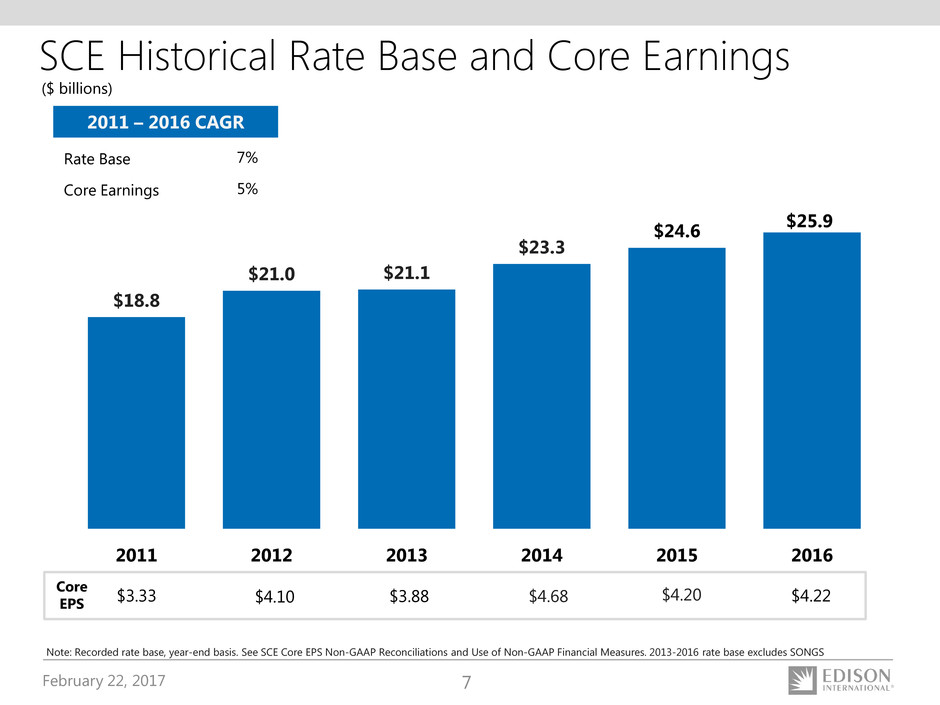
February 22, 2017 7
SCE Historical Rate Base and Core Earnings
Rate Base
Core Earnings
7%
5%
2011 – 2016 CAGR
($ billions)
Note: Recorded rate base, year-end basis. See SCE Core EPS Non-GAAP Reconciliations and Use of Non-GAAP Financial Measures. 2013-2016 rate base excludes SONGS
$18.8
$21.0 $21.1
$23.3
$24.6 $25.9
2011 2012 2013 2014 2015 2016
$4.20$4.68$3.33 $4.10 $3.88
Core
EPS $4.22
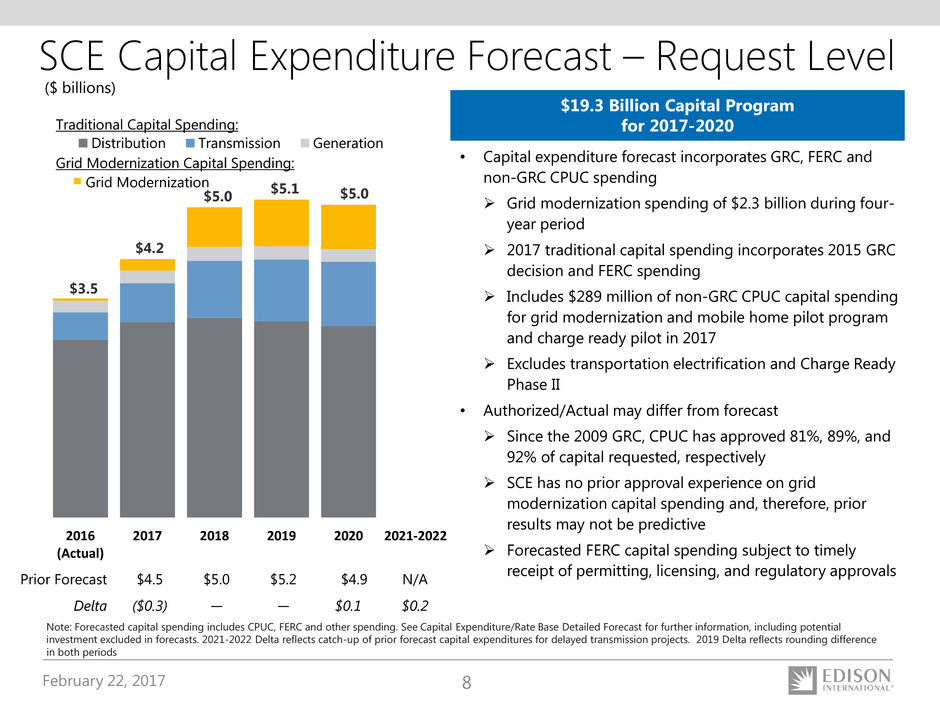
February 22, 2017 8
SCE Capital Expenditure Forecast – Request Level
Note: Forecasted capital spending includes CPUC, FERC and other spending. See Capital Expenditure/Rate Base Detailed Forecast for further information, including potential
investment excluded in forecasts. 2021-2022 Delta reflects catch-up of prior forecast capital expenditures for delayed transmission projects. 2019 Delta reflects rounding difference
in both periods
($ billions)
$19.3 Billion Capital Program
for 2017-2020
• Capital expenditure forecast incorporates GRC, FERC and
non-GRC CPUC spending
Grid modernization spending of $2.3 billion during four-
year period
2017 traditional capital spending incorporates 2015 GRC
decision and FERC spending
Includes $289 million of non-GRC CPUC capital spending
for grid modernization and mobile home pilot program
and charge ready pilot in 2017
Excludes transportation electrification and Charge Ready
Phase II
• Authorized/Actual may differ from forecast
Since the 2009 GRC, CPUC has approved 81%, 89%, and
92% of capital requested, respectively
SCE has no prior approval experience on grid
modernization capital spending and, therefore, prior
results may not be predictive
Forecasted FERC capital spending subject to timely
receipt of permitting, licensing, and regulatory approvalsPrior Forecast $4.5 $5.0 $5.2 $4.9 N/A
Delta ($0.3) — — $0.1 $0.2
$3.5
$4.2
$5.0 $5.1 $5.0
2016
(Actual)
2017 2018 2019 2020 2021-2022
Distribution Transmission Generation
Traditional Capital Spending:
Grid Modernization Capital Spending:
Grid Modernization
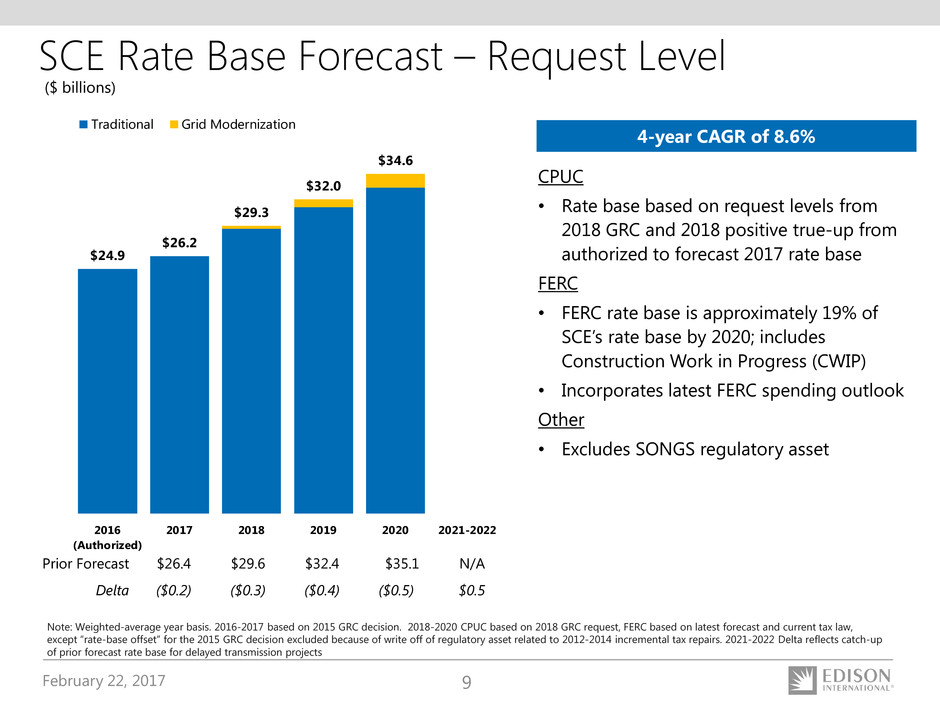
February 22, 2017 9
SCE Rate Base Forecast – Request Level
CPUC
• Rate base based on request levels from
2018 GRC and 2018 positive true-up from
authorized to forecast 2017 rate base
FERC
• FERC rate base is approximately 19% of
SCE’s rate base by 2020; includes
Construction Work in Progress (CWIP)
• Incorporates latest FERC spending outlook
Other
• Excludes SONGS regulatory asset
($ billions)
Note: Weighted-average year basis. 2016-2017 based on 2015 GRC decision. 2018-2020 CPUC based on 2018 GRC request, FERC based on latest forecast and current tax law,
except “rate-base offset” for the 2015 GRC decision excluded because of write off of regulatory asset related to 2012-2014 incremental tax repairs. 2021-2022 Delta reflects catch-up
of prior forecast rate base for delayed transmission projects
4-year CAGR of 8.6%
Prior Forecast $26.4 $29.6 $32.4 $35.1 N/A
Delta ($0.2) ($0.3) ($0.4) ($0.5) $0.5
$24.9
$26.2
$29.3
$32.0
$34.6
2016
(Authorized)
2017 2018 2019 2020 2021-2022
Traditional Grid Modernization
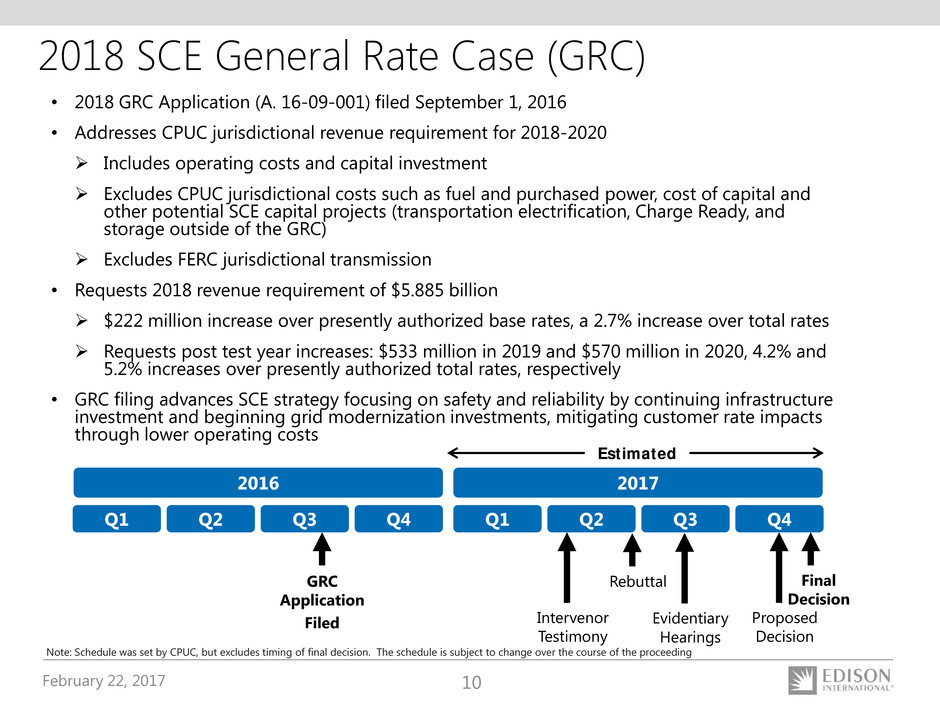
February 22, 2017 10
• 2018 GRC Application (A. 16-09-001) filed September 1, 2016
• Addresses CPUC jurisdictional revenue requirement for 2018-2020
Includes operating costs and capital investment
Excludes CPUC jurisdictional costs such as fuel and purchased power, cost of capital and
other potential SCE capital projects (transportation electrification, Charge Ready, and
storage outside of the GRC)
Excludes FERC jurisdictional transmission
• Requests 2018 revenue requirement of $5.885 billion
$222 million increase over presently authorized base rates, a 2.7% increase over total rates
Requests post test year increases: $533 million in 2019 and $570 million in 2020, 4.2% and
5.2% increases over presently authorized total rates, respectively
• GRC filing advances SCE strategy focusing on safety and reliability by continuing infrastructure
investment and beginning grid modernization investments, mitigating customer rate impacts
through lower operating costs
GRC
Application
Filed
Rebuttal Final
Decision
2016 2017
Q1 Q2 Q3 Q4 Q1 Q2 Q3 Q4
Estimated
Intervenor
Testimony
Proposed
Decision
2018 SCE General Rate Case (GRC)
Evidentiary
Hearings
Note: Schedule was set by CPUC, but excludes timing of final decision. The schedule is subject to change over the course of the proceeding
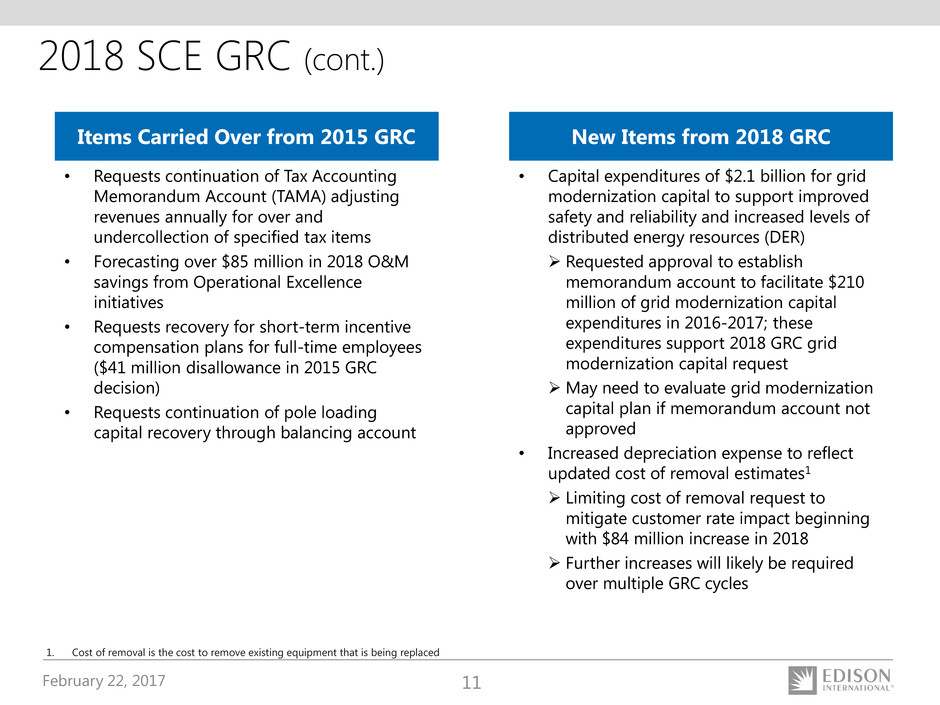
February 22, 2017 11
• Capital expenditures of $2.1 billion for grid
modernization capital to support improved
safety and reliability and increased levels of
distributed energy resources (DER)
Requested approval to establish
memorandum account to facilitate $210
million of grid modernization capital
expenditures in 2016-2017; these
expenditures support 2018 GRC grid
modernization capital request
May need to evaluate grid modernization
capital plan if memorandum account not
approved
• Increased depreciation expense to reflect
updated cost of removal estimates1
Limiting cost of removal request to
mitigate customer rate impact beginning
with $84 million increase in 2018
Further increases will likely be required
over multiple GRC cycles
Items Carried Over from 2015 GRC New Items from 2018 GRC
• Requests continuation of Tax Accounting
Memorandum Account (TAMA) adjusting
revenues annually for over and
undercollection of specified tax items
• Forecasting over $85 million in 2018 O&M
savings from Operational Excellence
initiatives
• Requests recovery for short-term incentive
compensation plans for full-time employees
($41 million disallowance in 2015 GRC
decision)
• Requests continuation of pole loading
capital recovery through balancing account
1. Cost of removal is the cost to remove existing equipment that is being replaced
2018 SCE GRC (cont.)
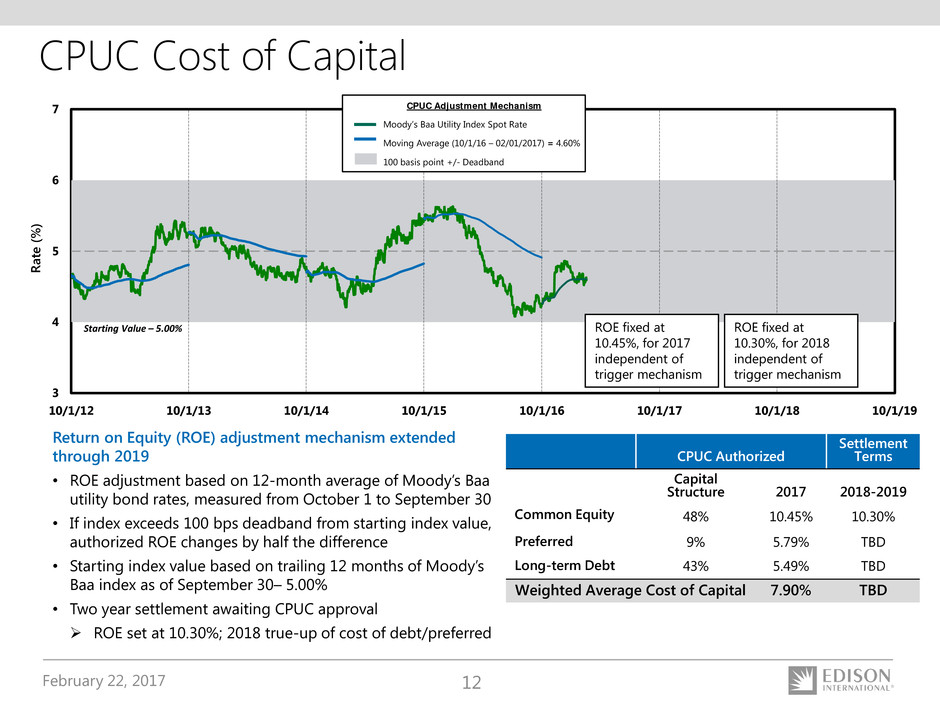
February 22, 2017 12
3
4
5
6
7
10/1/12 10/1/13 10/1/14 10/1/15 10/1/16 10/1/17 10/1/18 10/1/19
R
at
e
(%
)
CPUC Cost of Capital
CPUC Adjustment Mechanism
Moody’s Baa Utility Index Spot Rate
Moving Average (10/1/16 – 02/01/2017) = 4.60%
100 basis point +/- Deadband
Starting Value – 5.00%
Return on Equity (ROE) adjustment mechanism extended
through 2019
• ROE adjustment based on 12-month average of Moody’s Baa
utility bond rates, measured from October 1 to September 30
• If index exceeds 100 bps deadband from starting index value,
authorized ROE changes by half the difference
• Starting index value based on trailing 12 months of Moody’s
Baa index as of September 30– 5.00%
• Two year settlement awaiting CPUC approval
ROE set at 10.30%; 2018 true-up of cost of debt/preferred
CPUC Authorized
Settlement
Terms
Capital
Structure 2017 2018-2019
Common Equity 48% 10.45% 10.30%
Preferred 9% 5.79% TBD
Long-term Debt 43% 5.49% TBD
Weighted Average Cost of Capital 7.90% TBD
ROE fixed at
10.30%, for 2018
independent of
trigger mechanism
ROE fixed at
10.45%, for 2017
independent of
trigger mechanism
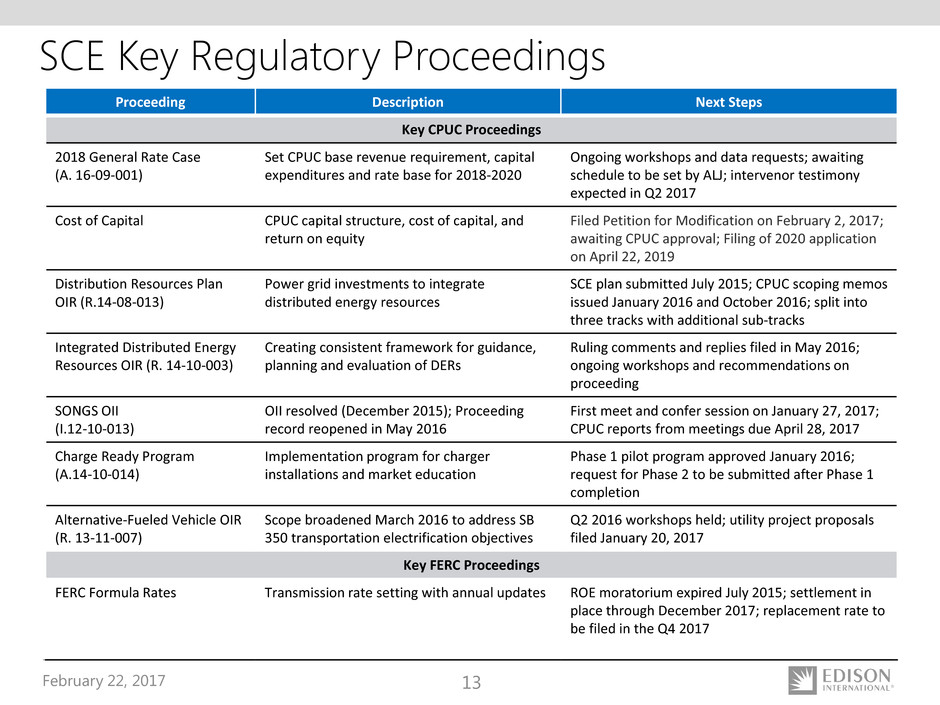
February 22, 2017 13
SCE Key Regulatory Proceedings
Proceeding Description Next Steps
Key CPUC Proceedings
2018 General Rate Case
(A. 16-09-001)
Set CPUC base revenue requirement, capital
expenditures and rate base for 2018-2020
Ongoing workshops and data requests; awaiting
schedule to be set by ALJ; intervenor testimony
expected in Q2 2017
Cost of Capital CPUC capital structure, cost of capital, and
return on equity
Filed Petition for Modification on February 2, 2017;
awaiting CPUC approval; Filing of 2020 application
on April 22, 2019
Distribution Resources Plan
OIR (R.14-08-013)
Power grid investments to integrate
distributed energy resources
SCE plan submitted July 2015; CPUC scoping memos
issued January 2016 and October 2016; split into
three tracks with additional sub-tracks
Integrated Distributed Energy
Resources OIR (R. 14-10-003)
Creating consistent framework for guidance,
planning and evaluation of DERs
Ruling comments and replies filed in May 2016;
ongoing workshops and recommendations on
proceeding
SONGS OII
(I.12-10-013)
OII resolved (December 2015); Proceeding
record reopened in May 2016
First meet and confer session on January 27, 2017;
CPUC reports from meetings due April 28, 2017
Charge Ready Program
(A.14-10-014)
Implementation program for charger
installations and market education
Phase 1 pilot program approved January 2016;
request for Phase 2 to be submitted after Phase 1
completion
Alternative-Fueled Vehicle OIR
(R. 13-11-007)
Scope broadened March 2016 to address SB
350 transportation electrification objectives
Q2 2016 workshops held; utility project proposals
filed January 20, 2017
Key FERC Proceedings
FERC Formula Rates Transmission rate setting with annual updates ROE moratorium expired July 2015; settlement in
place through December 2017; replacement rate to
be filed in the Q4 2017
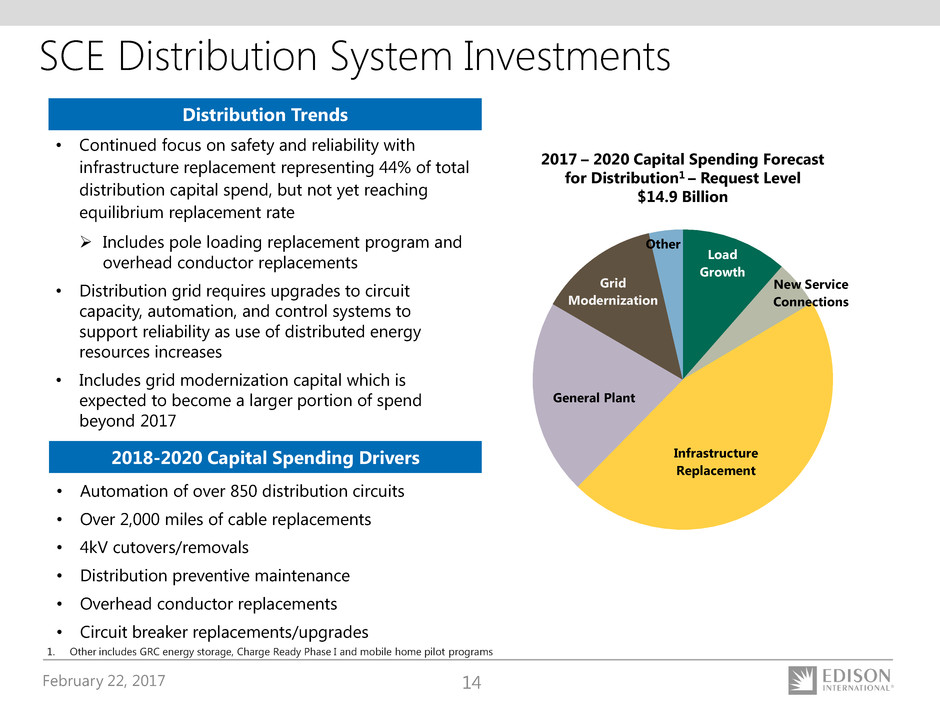
February 22, 2017 14
SCE Distribution System Investments
1. Other includes GRC energy storage, Charge Ready Phase I and mobile home pilot programs
Distribution Trends
• Continued focus on safety and reliability with
infrastructure replacement representing 44% of total
distribution capital spend, but not yet reaching
equilibrium replacement rate
Includes pole loading replacement program and
overhead conductor replacements
• Distribution grid requires upgrades to circuit
capacity, automation, and control systems to
support reliability as use of distributed energy
resources increases
• Includes grid modernization capital which is
expected to become a larger portion of spend
beyond 2017
2017 – 2020 Capital Spending Forecast
for Distribution1 – Request Level
$14.9 Billion
2018-2020 Capital Spending Drivers
• Automation of over 850 distribution circuits
• Over 2,000 miles of cable replacements
• 4kV cutovers/removals
• Distribution preventive maintenance
• Overhead conductor replacements
• Circuit breaker replacements/upgrades
Load
Growth
New Service
Connections
Infrastructure
Replacement
General Plant
Grid
Modernization
Other
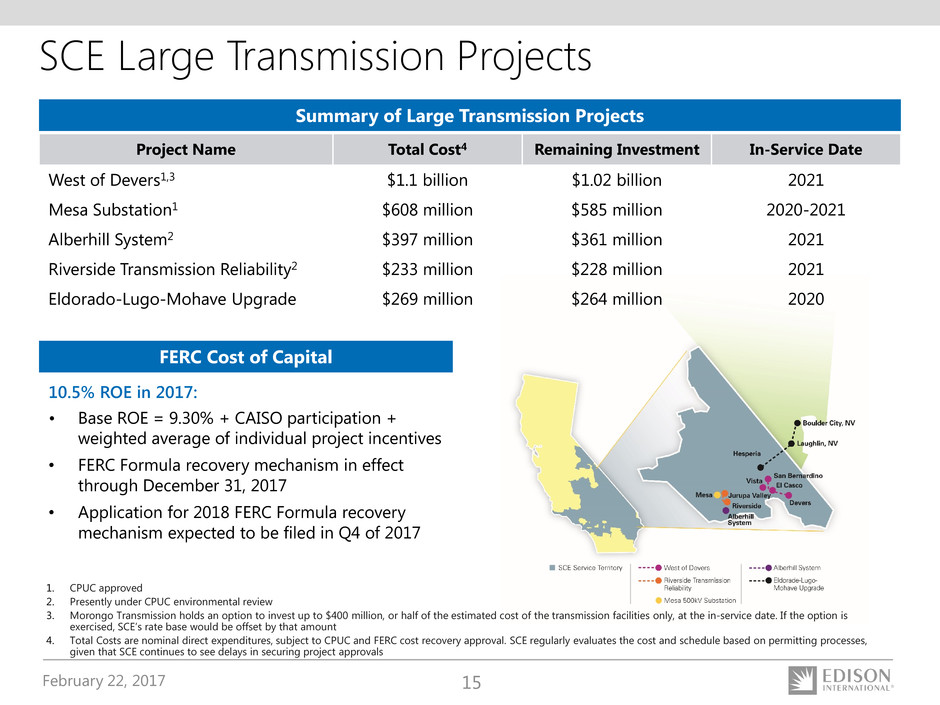
February 22, 2017 15
SCE Large Transmission Projects
1. CPUC approved
2. Presently under CPUC environmental review
3. Morongo Transmission holds an option to invest up to $400 million, or half of the estimated cost of the transmission facilities only, at the in-service date. If the option is
exercised, SCE’s rate base would be offset by that amount
4. Total Costs are nominal direct expenditures, subject to CPUC and FERC cost recovery approval. SCE regularly evaluates the cost and schedule based on permitting processes,
given that SCE continues to see delays in securing project approvals
FERC Cost of Capital
10.5% ROE in 2017:
• Base ROE = 9.30% + CAISO participation +
weighted average of individual project incentives
• FERC Formula recovery mechanism in effect
through December 31, 2017
• Application for 2018 FERC Formula recovery
mechanism expected to be filed in Q4 of 2017
Summary of Large Transmission Projects
Project Name Total Cost4 Remaining Investment In-Service Date
West of Devers1,3 $1.1 billion $1.02 billion 2021
Mesa Substation1 $608 million $585 million 2020-2021
Alberhill System2 $397 million $361 million 2021
Riverside Transmission Reliability2 $233 million $228 million 2021
Eldorado-Lugo-Mohave Upgrade $269 million $264 million 2020
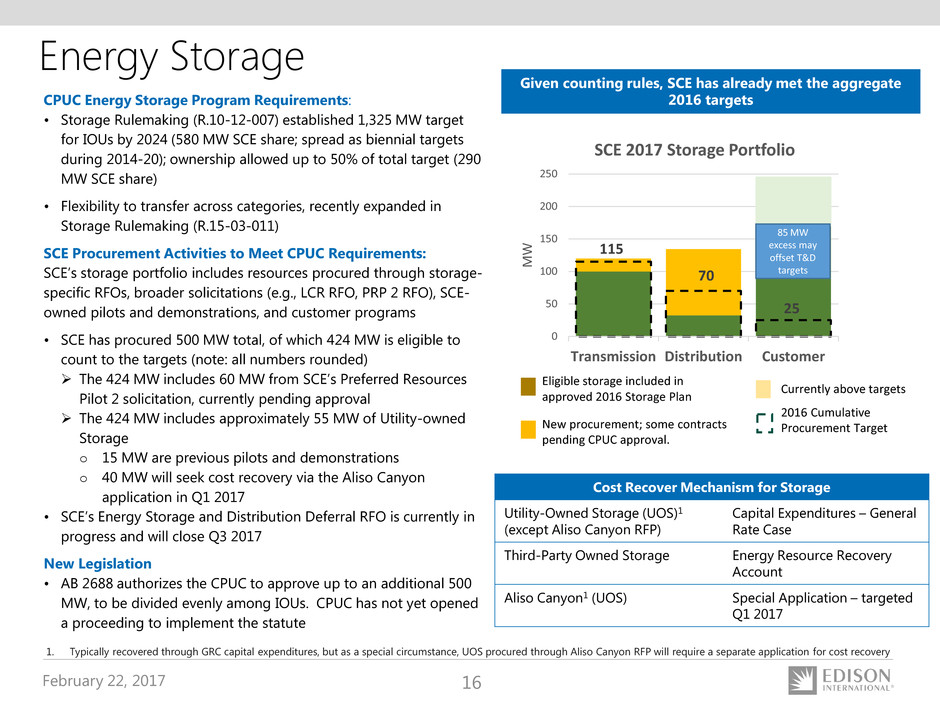
February 22, 2017 16
Energy Storage
Given counting rules, SCE has already met the aggregate
2016 targetsCPUC Energy Storage Program Requirements:
• Storage Rulemaking (R.10-12-007) established 1,325 MW target
for IOUs by 2024 (580 MW SCE share; spread as biennial targets
during 2014-20); ownership allowed up to 50% of total target (290
MW SCE share)
• Flexibility to transfer across categories, recently expanded in
Storage Rulemaking (R.15-03-011)
SCE Procurement Activities to Meet CPUC Requirements:
SCE’s storage portfolio includes resources procured through storage-
specific RFOs, broader solicitations (e.g., LCR RFO, PRP 2 RFO), SCE-
owned pilots and demonstrations, and customer programs
• SCE has procured 500 MW total, of which 424 MW is eligible to
count to the targets (note: all numbers rounded)
The 424 MW includes 60 MW from SCE’s Preferred Resources
Pilot 2 solicitation, currently pending approval
The 424 MW includes approximately 55 MW of Utility-owned
Storage
o 15 MW are previous pilots and demonstrations
o 40 MW will seek cost recovery via the Aliso Canyon
application in Q1 2017
• SCE’s Energy Storage and Distribution Deferral RFO is currently in
progress and will close Q3 2017
New Legislation
• AB 2688 authorizes the CPUC to approve up to an additional 500
MW, to be divided evenly among IOUs. CPUC has not yet opened
a proceeding to implement the statute
Cost Recover Mechanism for Storage
Utility-Owned Storage (UOS)1
(except Aliso Canyon RFP)
Capital Expenditures – General
Rate Case
Third-Party Owned Storage Energy Resource Recovery
Account
Aliso Canyon1 (UOS) Special Application – targeted
Q1 2017
1. Typically recovered through GRC capital expenditures, but as a special circumstance, UOS procured through Aliso Canyon RFP will require a separate application for cost recovery
115
70
25
0
50
100
150
200
250
Transmission Distribution Customer
M
W
SCE 2017 Storage Portfolio
85 MW
excess may
offset T&D
targets
Eligible storage included in
approved 2016 Storage Plan
New procurement; some contracts
pending CPUC approval.
Currently above targets
2016 Cumulative
Procurement Target
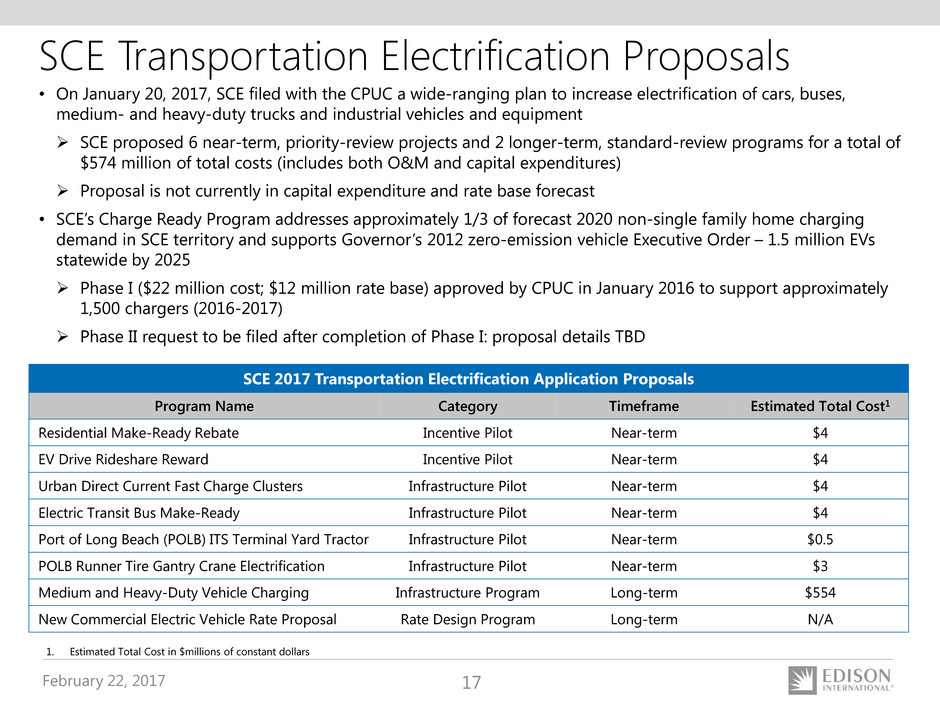
February 22, 2017 17
SCE Transportation Electrification Proposals
• On January 20, 2017, SCE filed with the CPUC a wide-ranging plan to increase electrification of cars, buses,
medium- and heavy-duty trucks and industrial vehicles and equipment
SCE proposed 6 near-term, priority-review projects and 2 longer-term, standard-review programs for a total of
$574 million of total costs (includes both O&M and capital expenditures)
Proposal is not currently in capital expenditure and rate base forecast
• SCE’s Charge Ready Program addresses approximately 1/3 of forecast 2020 non-single family home charging
demand in SCE territory and supports Governor’s 2012 zero-emission vehicle Executive Order – 1.5 million EVs
statewide by 2025
Phase I ($22 million cost; $12 million rate base) approved by CPUC in January 2016 to support approximately
1,500 chargers (2016-2017)
Phase II request to be filed after completion of Phase I: proposal details TBD
SCE 2017 Transportation Electrification Application Proposals
Program Name Category Timeframe Estimated Total Cost1
Residential Make-Ready Rebate Incentive Pilot Near-term $4
EV Drive Rideshare Reward Incentive Pilot Near-term $4
Urban Direct Current Fast Charge Clusters Infrastructure Pilot Near-term $4
Electric Transit Bus Make-Ready Infrastructure Pilot Near-term $4
Port of Long Beach (POLB) ITS Terminal Yard Tractor Infrastructure Pilot Near-term $0.5
POLB Runner Tire Gantry Crane Electrification Infrastructure Pilot Near-term $3
Medium and Heavy-Duty Vehicle Charging Infrastructure Program Long-term $554
New Commercial Electric Vehicle Rate Proposal Rate Design Program Long-term N/A
1. Estimated Total Cost in $millions of constant dollars
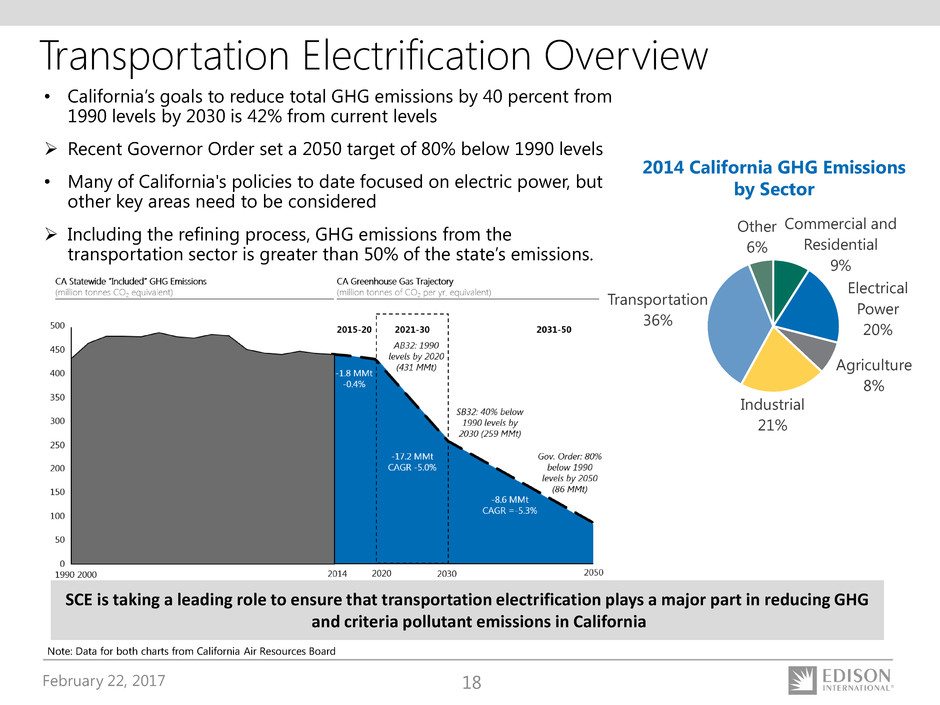
February 22, 2017 18
Transportation Electrification Overview
• California’s goals to reduce total GHG emissions by 40 percent from
1990 levels by 2030 is 42% from current levels
Recent Governor Order set a 2050 target of 80% below 1990 levels
• Many of California's policies to date focused on electric power, but
other key areas need to be considered
Including the refining process, GHG emissions from the
transportation sector is greater than 50% of the state’s emissions.
Commercial and
Residential
9%
Electrical
Power
20%
Agriculture
8%
Industrial
21%
Transportation
36%
Other
6%
SCE is taking a leading role to ensure that transportation electrification plays a major part in reducing GHG
and criteria pollutant emissions in California
2014 California GHG Emissions
by Sector
Note: Data for both charts from California Air Resources Board
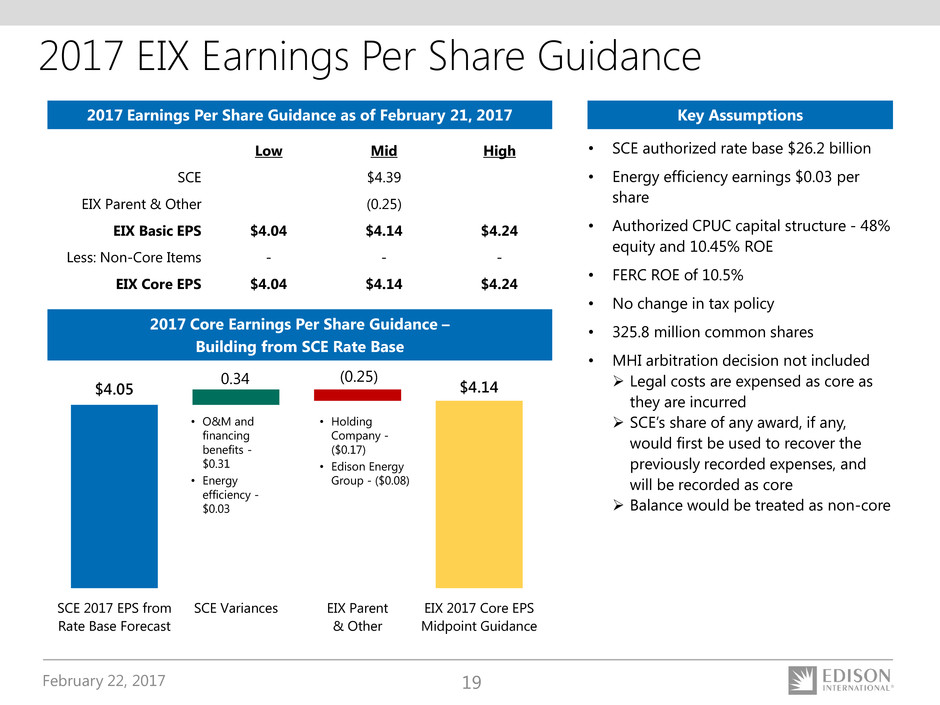
February 22, 2017 19
$4.05 $4.14
(0.25)0.34
SCE 2017 EPS from
Rate Base Forecast
SCE Variances EIX Parent
& Other
EIX 2017 Core EPS
Midpoint Guidance
• O&M and
financing
benefits -
$0.31
• Energy
efficiency -
$0.03
2017 Core Earnings Per Share Guidance –
Building from SCE Rate Base
• SCE authorized rate base $26.2 billion
• Energy efficiency earnings $0.03 per
share
• Authorized CPUC capital structure - 48%
equity and 10.45% ROE
• FERC ROE of 10.5%
• No change in tax policy
• 325.8 million common shares
• MHI arbitration decision not included
Legal costs are expensed as core as
they are incurred
SCE’s share of any award, if any,
would first be used to recover the
previously recorded expenses, and
will be recorded as core
Balance would be treated as non-core
Key Assumptions
Low Mid High
SCE $4.39
EIX Parent & Other (0.25)
EIX Basic EPS $4.04 $4.14 $4.24
Less: Non-Core Items - - -
EIX Core EPS $4.04 $4.14 $4.24
• Holding
Company -
($0.17)
• Edison Energy
Group - ($0.08)
2017 Earnings Per Share Guidance as of February 21, 2017
2017 EIX Earnings Per Share Guidance
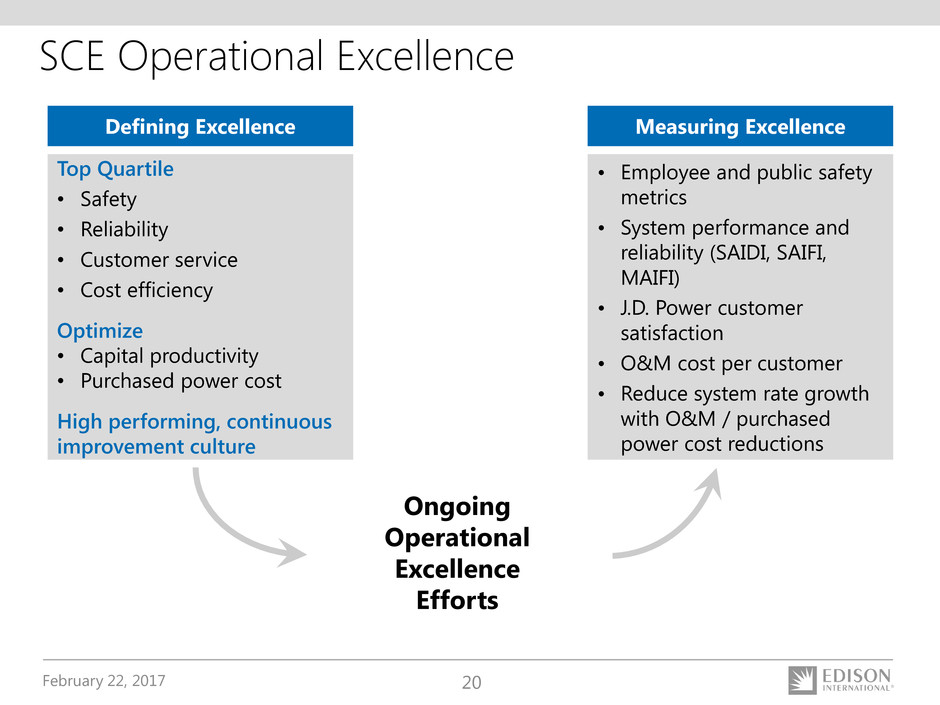
February 22, 2017 20
SCE Operational Excellence
Top Quartile
• Safety
• Reliability
• Customer service
• Cost efficiency
Optimize
• Capital productivity
• Purchased power cost
High performing, continuous
improvement culture
Defining Excellence Measuring Excellence
• Employee and public safety
metrics
• System performance and
reliability (SAIDI, SAIFI,
MAIFI)
• J.D. Power customer
satisfaction
• O&M cost per customer
• Reduce system rate growth
with O&M / purchased
power cost reductions
Ongoing
Operational
Excellence
Efforts

February 22, 2017 21
Responding to Industry Change
• Public policy and large commercial
customers prioritizing sustainability
objectives
• Innovation facilitating conservation and
self-generation
• Regulation supporting new forms of
competition
• Flattening domestic demand for
electricity
• Power grid of the future will be more
complex and sophisticated to support
increasing use of distributed resources
and transportation electrification
SCE Strategy
• Invest in, build, and operate the next
generation electric power grid
• Operational and service excellence
• Enable California public policies
Edison Energy Group
• Position as an independent Energy
Advisor and Integrator for large
commercial and industrial customers –
capital light business model
• Solar opportunities focused on
commercial and industrial customers, co-
operatives and community solar
programs
• Founding member of Grid AssuranceTM
Long-Term Industry Trends Strategy
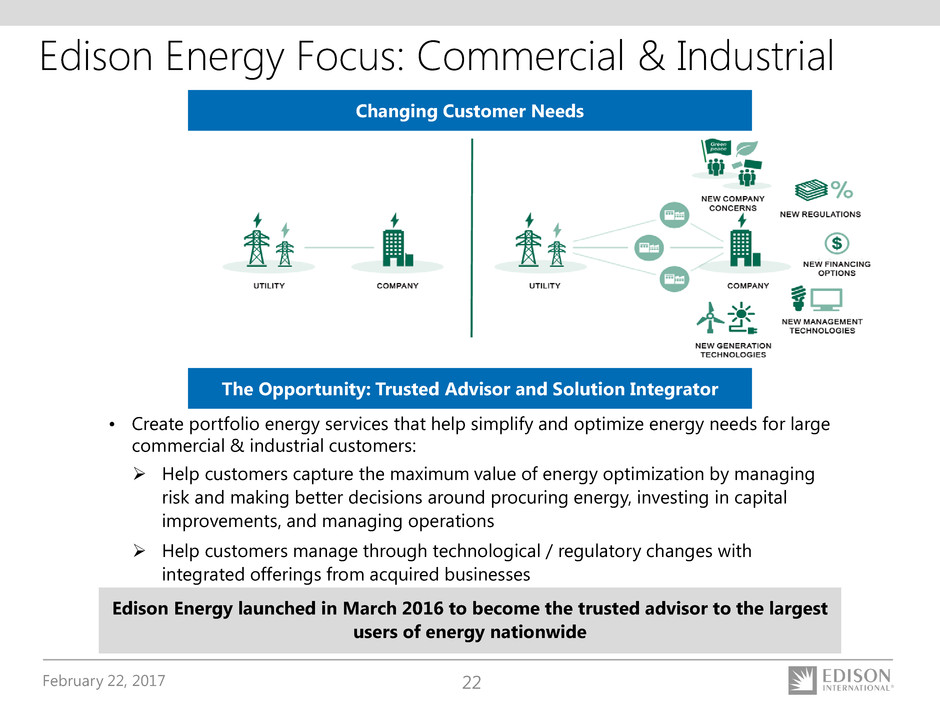
February 22, 2017 22
• Create portfolio energy services that help simplify and optimize energy needs for large
commercial & industrial customers:
Help customers capture the maximum value of energy optimization by managing
risk and making better decisions around procuring energy, investing in capital
improvements, and managing operations
Help customers manage through technological / regulatory changes with
integrated offerings from acquired businesses
Edison Energy launched in March 2016 to become the trusted advisor to the largest
users of energy nationwide
Changing Customer Needs
The Opportunity: Trusted Advisor and Solution Integrator
Edison Energy Focus: Commercial & Industrial
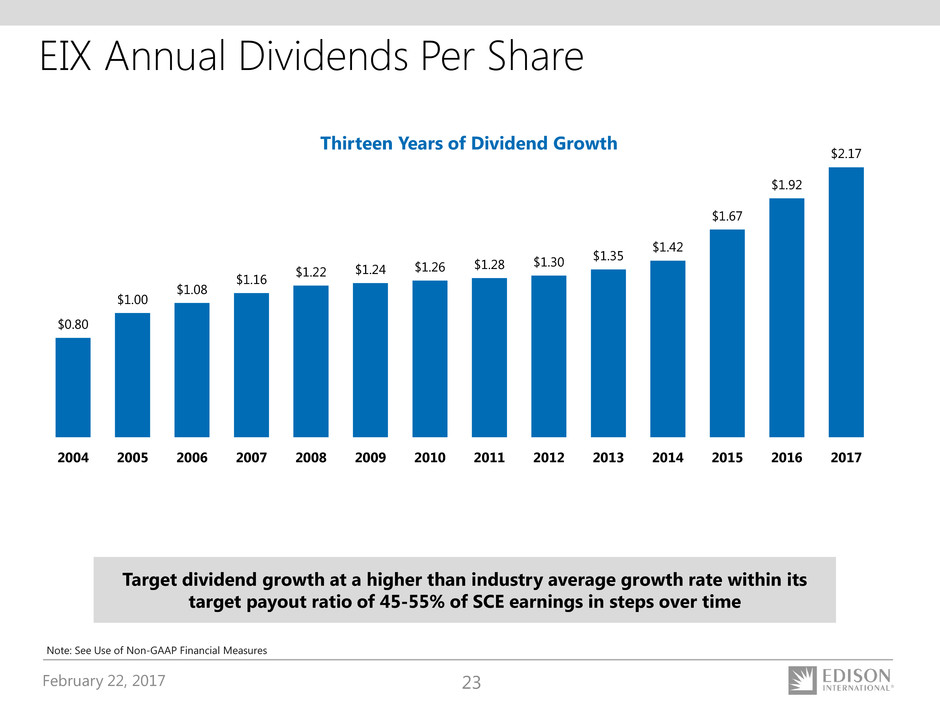
February 22, 2017 23
EIX Annual Dividends Per Share
$0.80
$1.00
$1.08
$1.16 $1.22
$1.24 $1.26 $1.28 $1.30
$1.35
$1.42
$1.67
$1.92
$2.17
2004 2005 2006 2007 2008 2009 2010 2011 2012 2013 2014 2015 2016 2017
Note: See Use of Non-GAAP Financial Measures
Thirteen Years of Dividend Growth
Target dividend growth at a higher than industry average growth rate within its
target payout ratio of 45-55% of SCE earnings in steps over time
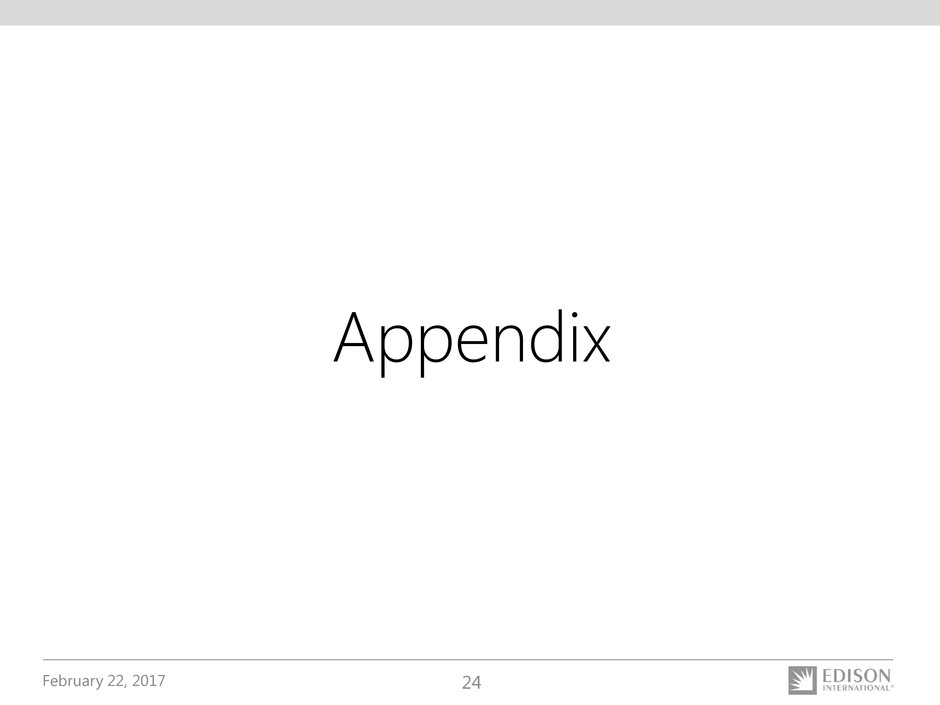
February 22, 2017 24
Appendix
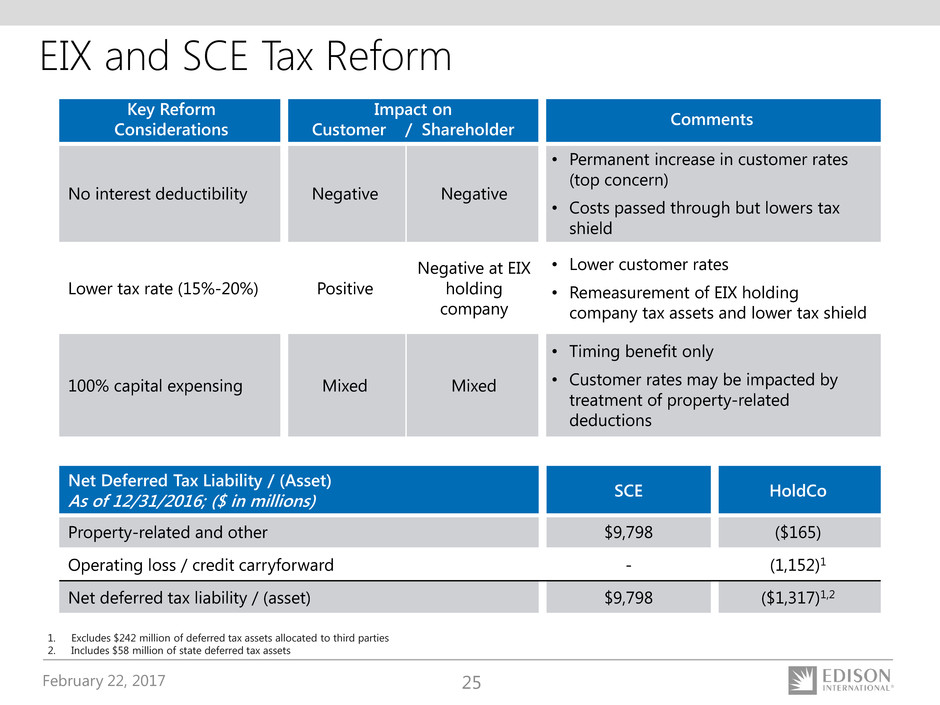
February 22, 2017 25
Key Reform
Considerations
Impact on
Customer / Shareholder
Comments
No interest deductibility Negative Negative
• Permanent increase in customer rates
(top concern)
• Costs passed through but lowers tax
shield
Lower tax rate (15%-20%) Positive
Negative at EIX
holding
company
• Lower customer rates
• Remeasurement of EIX holding
company tax assets and lower tax shield
100% capital expensing Mixed Mixed
• Timing benefit only
• Customer rates may be impacted by
treatment of property-related
deductions
Net Deferred Tax Liability / (Asset)
As of 12/31/2016; ($ in millions) SCE HoldCo
Property-related and other $9,798 ($165)
Operating loss / credit carryforward - (1,152)1
Net deferred tax liability / (asset) $9,798 ($1,317)1,2
1. Excludes $242 million of deferred tax assets allocated to third parties
2. Includes $58 million of state deferred tax assets
EIX and SCE Tax Reform
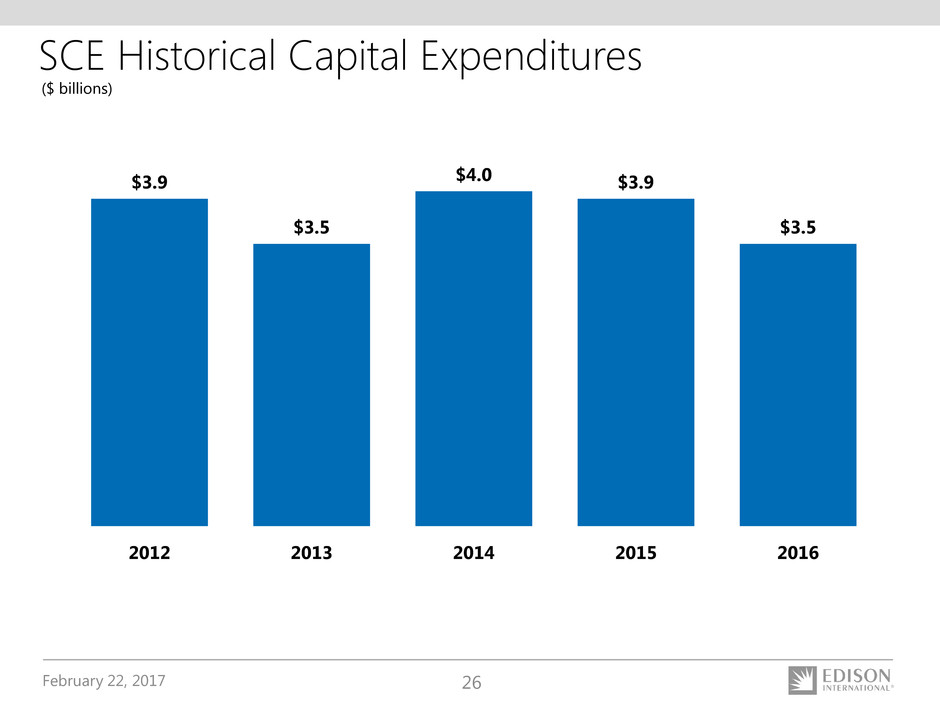
February 22, 2017 26
SCE Historical Capital Expenditures
($ billions)
$3.9
$3.5
$4.0 $3.9
$3.5
2012 2013 2014 2015 2016
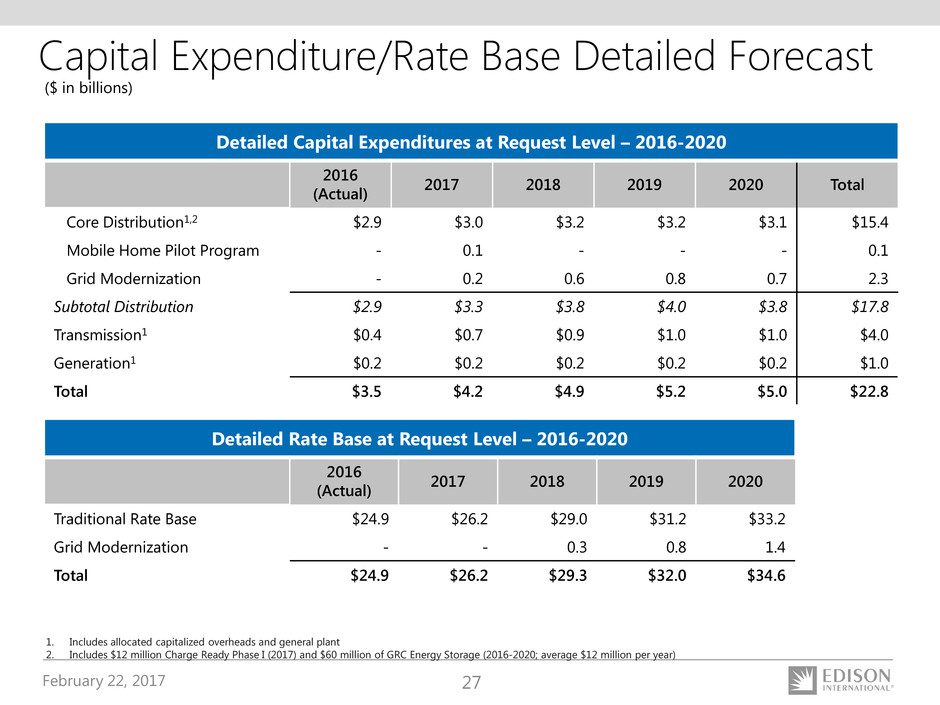
February 22, 2017 27
Detailed Capital Expenditures at Request Level – 2016-2020
2016
(Actual)
2017 2018 2019 2020 Total
Core Distribution1,2 $2.9 $3.0 $3.2 $3.2 $3.1 $15.4
Mobile Home Pilot Program - 0.1 - - - 0.1
Grid Modernization - 0.2 0.6 0.8 0.7 2.3
Subtotal Distribution $2.9 $3.3 $3.8 $4.0 $3.8 $17.8
Transmission1 $0.4 $0.7 $0.9 $1.0 $1.0 $4.0
Generation1 $0.2 $0.2 $0.2 $0.2 $0.2 $1.0
Total $3.5 $4.2 $4.9 $5.2 $5.0 $22.8
Capital Expenditure/Rate Base Detailed Forecast
Detailed Rate Base at Request Level – 2016-2020
2016
(Actual) 2017 2018 2019 2020
Traditional Rate Base $24.9 $26.2 $29.0 $31.2 $33.2
Grid Modernization - - 0.3 0.8 1.4
Total $24.9 $26.2 $29.3 $32.0 $34.6
1. Includes allocated capitalized overheads and general plant
2. Includes $12 million Charge Ready Phase I (2017) and $60 million of GRC Energy Storage (2016-2020; average $12 million per year)
($ in billions)
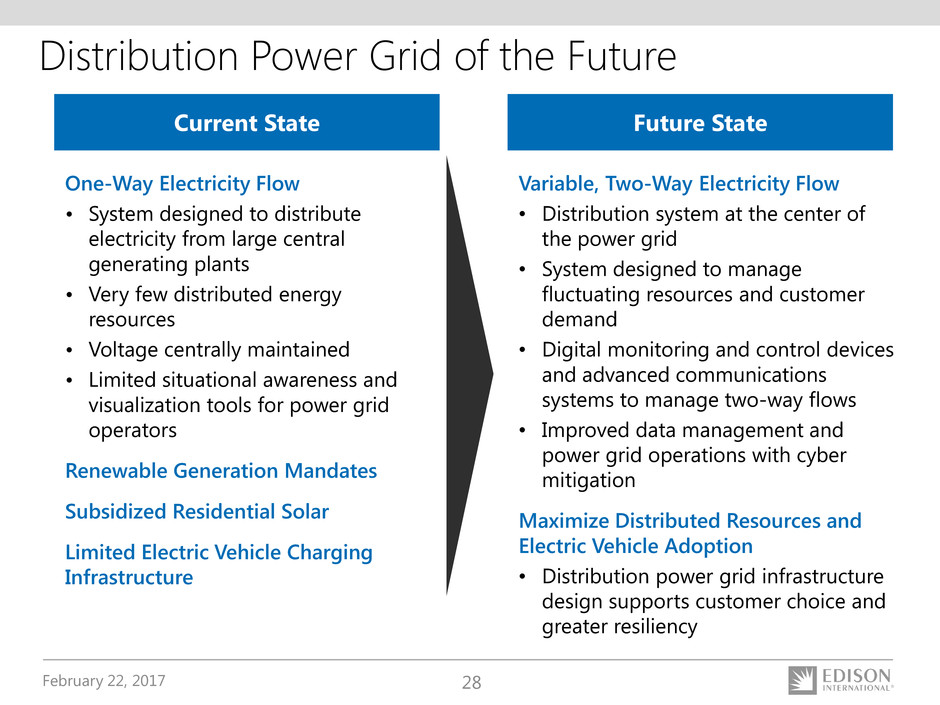
February 22, 2017 28
Distribution Power Grid of the Future
One-Way Electricity Flow
• System designed to distribute
electricity from large central
generating plants
• Very few distributed energy
resources
• Voltage centrally maintained
• Limited situational awareness and
visualization tools for power grid
operators
Renewable Generation Mandates
Subsidized Residential Solar
Limited Electric Vehicle Charging
Infrastructure
Variable, Two-Way Electricity Flow
• Distribution system at the center of
the power grid
• System designed to manage
fluctuating resources and customer
demand
• Digital monitoring and control devices
and advanced communications
systems to manage two-way flows
• Improved data management and
power grid operations with cyber
mitigation
Maximize Distributed Resources and
Electric Vehicle Adoption
• Distribution power grid infrastructure
design supports customer choice and
greater resiliency
Current State Future State
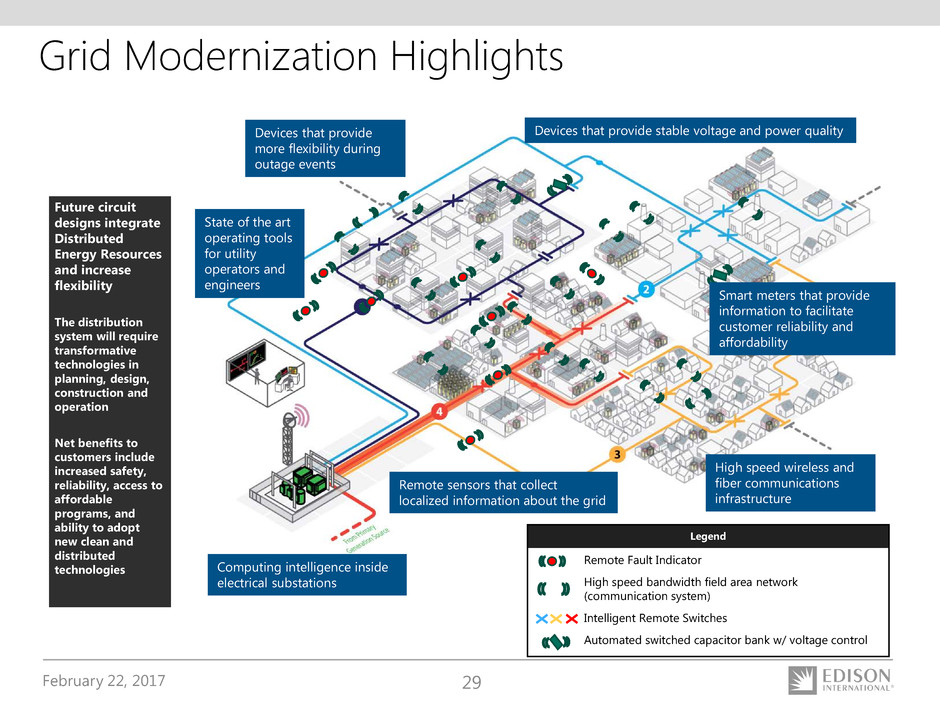
February 22, 2017 29
Computing intelligence inside
electrical substations
Future circuit
designs integrate
Distributed
Energy Resources
and increase
flexibility
The distribution
system will require
transformative
technologies in
planning, design,
construction and
operation
Net benefits to
customers include
increased safety,
reliability, access to
affordable
programs, and
ability to adopt
new clean and
distributed
technologies
State of the art
operating tools
for utility
operators and
engineers
Remote sensors that collect
localized information about the grid
Devices that provide
more flexibility during
outage events
Devices that provide stable voltage and power quality
High speed wireless and
fiber communications
infrastructure
Smart meters that provide
information to facilitate
customer reliability and
affordability
Grid Modernization Highlights
Legend
Remote Fault Indicator
High speed bandwidth field area network
(communication system)
Intelligent Remote Switches
Automated switched capacitor bank w/ voltage control
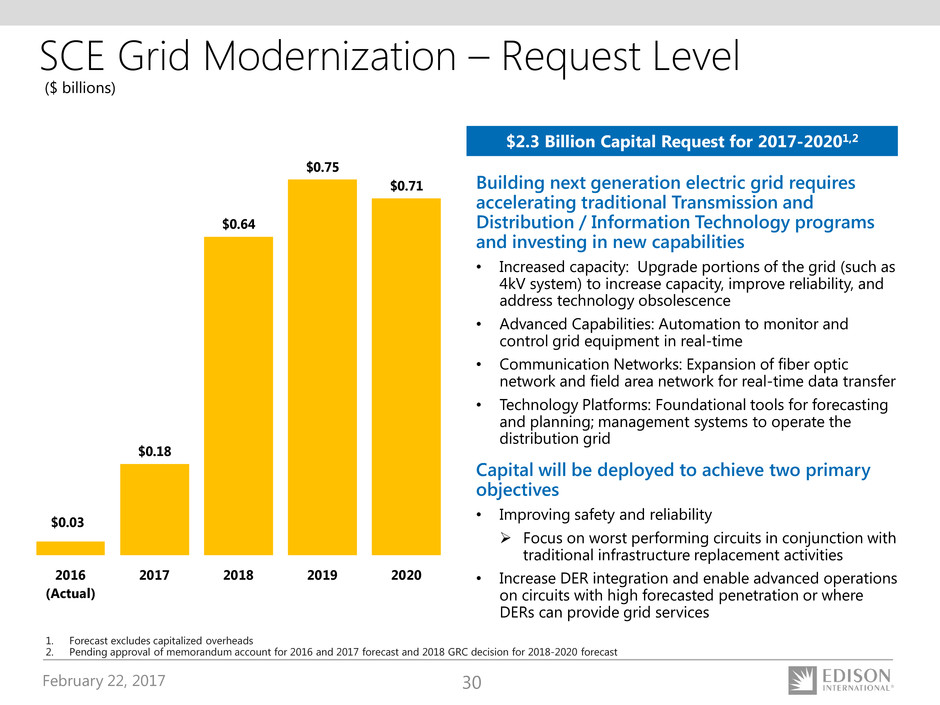
February 22, 2017 30
$0.03
$0.18
$0.64
$0.75
$0.71
2016
(Actual)
2017 2018 2019 2020
Building next generation electric grid requires
accelerating traditional Transmission and
Distribution / Information Technology programs
and investing in new capabilities
• Increased capacity: Upgrade portions of the grid (such as
4kV system) to increase capacity, improve reliability, and
address technology obsolescence
• Advanced Capabilities: Automation to monitor and
control grid equipment in real-time
• Communication Networks: Expansion of fiber optic
network and field area network for real-time data transfer
• Technology Platforms: Foundational tools for forecasting
and planning; management systems to operate the
distribution grid
Capital will be deployed to achieve two primary
objectives
• Improving safety and reliability
Focus on worst performing circuits in conjunction with
traditional infrastructure replacement activities
• Increase DER integration and enable advanced operations
on circuits with high forecasted penetration or where
DERs can provide grid services
1. Forecast excludes capitalized overheads
2. Pending approval of memorandum account for 2016 and 2017 forecast and 2018 GRC decision for 2018-2020 forecast
SCE Grid Modernization – Request Level
($ billions)
$2.3 Billion Capital Request for 2017-20201,2
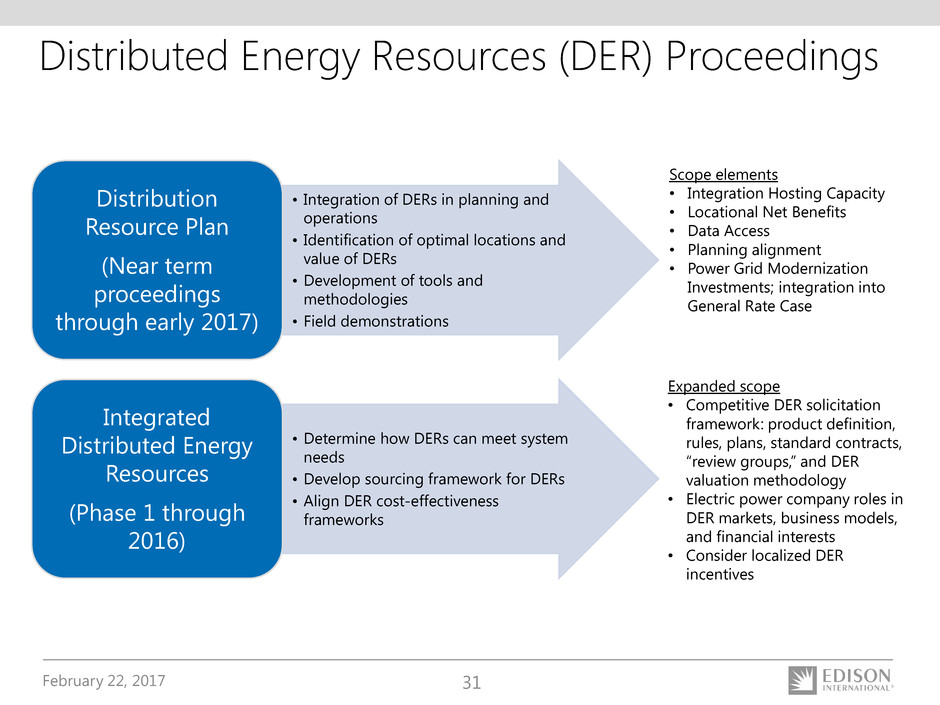
February 22, 2017 31
Distributed Energy Resources (DER) Proceedings
Expanded scope
• Competitive DER solicitation
framework: product definition,
rules, plans, standard contracts,
“review groups,” and DER
valuation methodology
• Electric power company roles in
DER markets, business models,
and financial interests
• Consider localized DER
incentives
Scope elements
• Integration Hosting Capacity
• Locational Net Benefits
• Data Access
• Planning alignment
• Power Grid Modernization
Investments; integration into
General Rate Case
• Integration of DERs in planning and
operations
• Identification of optimal locations and
value of DERs
• Development of tools and
methodologies
• Field demonstrations
Distribution
Resource Plan
(Near term
proceedings
through early 2017)
• Determine how DERs can meet system
needs
• Develop sourcing framework for DERs
• Align DER cost-effectiveness
frameworks
Integrated
Distributed Energy
Resources
(Phase 1 through
2016)

February 22, 2017 32
2016
29,141
41,565
7,056
4,645
1,776
84,183
1,794
85,977
4,417,340
565,222
10,445
46,133
21,233
133
22
5,060,528
38,076
23,091
SCE Customer Demand Trends
Kilowatt-Hour Sales (millions of kWh)
Residential
Commercial
Industrial
Public authorities
Agricultural and other
Subtotal
Resale
Total Kilowatt-Hour Sales
Customers
Residential
Commercial
Industrial
Public authorities
Agricultural
Railroads and railways
Interdepartmental
Total Number of Customers
Number of New Connections
Area Peak Demand (MW)
2012
30,563
40,541
8,504
5,196
1,676
86,480
1,735
88,215
4,321,171
549,855
10,922
46,493
21,917
83
24
4,950,465
22,866
21,996
2013
29,889
40,649
8,472
5,012
1,885
85,907
1,490
87,397
4,344,429
554,592
10,584
46,323
21,679
99
23
4,977,729
27,370
22,534
Note: See 2015 Edison International Financial and Statistical Reports for further information
2014
30,115
42,127
8,417
4,990
2,025
87,674
1,312
88,986
4,368,897
557,957
10,782
46,234
21,404
105
22
5,005,401
29,879
23,055
2015
29,959
42,207
7,589
4,774
1,940
86,469
1,075
87,544
4,393,150
561,475
10,811
46,436
21,306
130
22
5,033,330
31,653
23,079
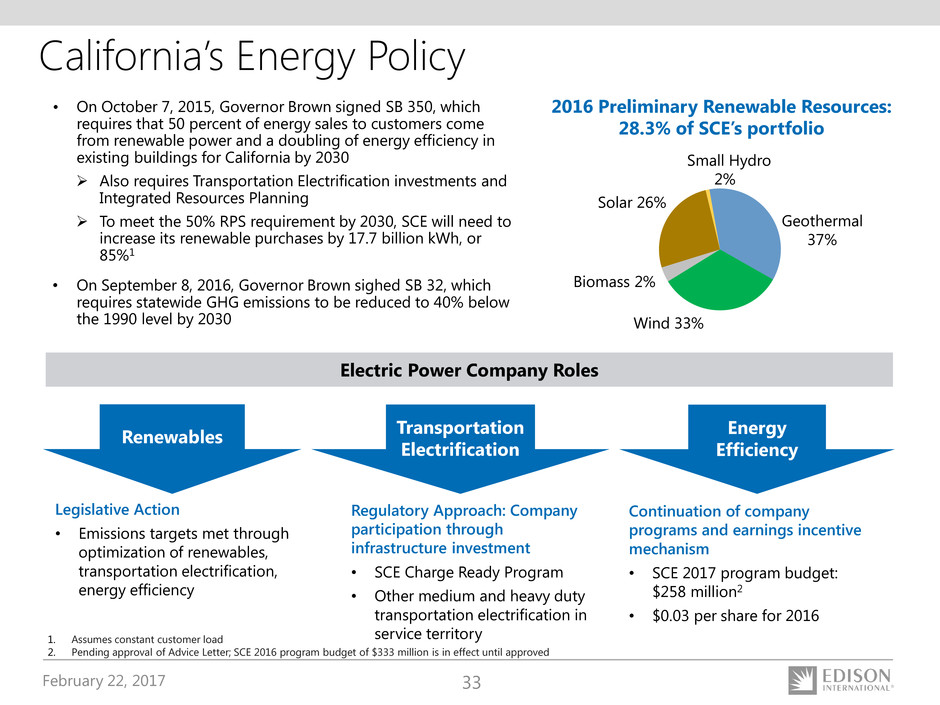
February 22, 2017 33
California’s Energy Policy
• On October 7, 2015, Governor Brown signed SB 350, which
requires that 50 percent of energy sales to customers come
from renewable power and a doubling of energy efficiency in
existing buildings for California by 2030
Also requires Transportation Electrification investments and
Integrated Resources Planning
To meet the 50% RPS requirement by 2030, SCE will need to
increase its renewable purchases by 17.7 billion kWh, or
85%1
• On September 8, 2016, Governor Brown sighed SB 32, which
requires statewide GHG emissions to be reduced to 40% below
the 1990 level by 2030
Renewables Transportation
Electrification
Energy
Efficiency
Legislative Action
• Emissions targets met through
optimization of renewables,
transportation electrification,
energy efficiency
Regulatory Approach: Company
participation through
infrastructure investment
• SCE Charge Ready Program
• Other medium and heavy duty
transportation electrification in
service territory
Continuation of company
programs and earnings incentive
mechanism
• SCE 2017 program budget:
$258 million2
• $0.03 per share for 2016
Electric Power Company Roles
Solar 26%
Small Hydro
2%
Geothermal
37%
Wind 33%
2016 Preliminary Renewable Resources:
28.3% of SCE’s portfolio
Biomass 2%
1. Assumes constant customer load
2. Pending approval of Advice Letter; SCE 2016 program budget of $333 million is in effect until approved
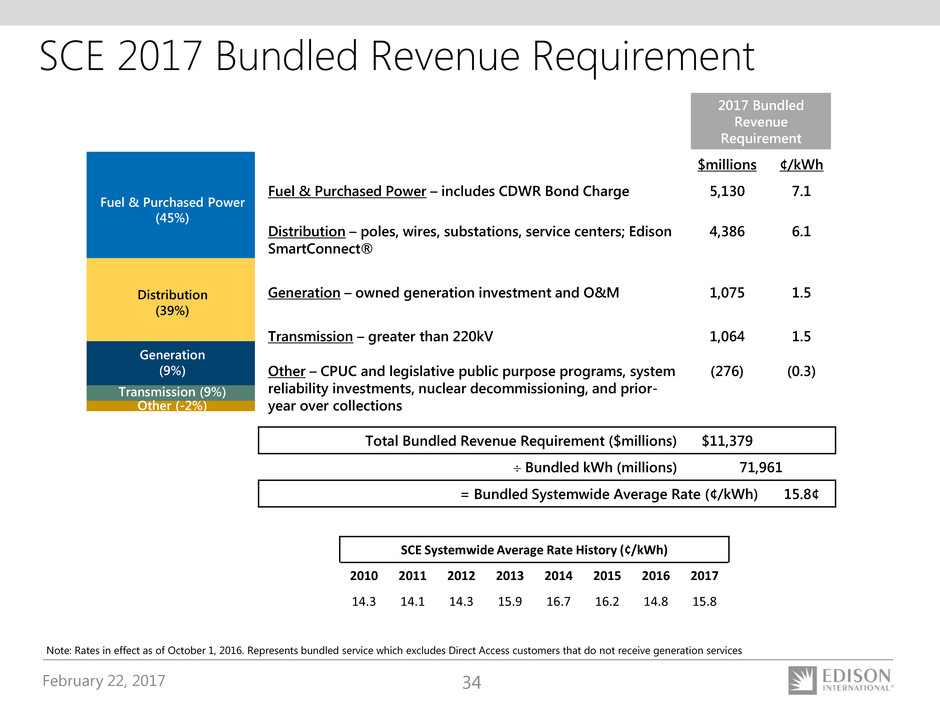
February 22, 2017 34
SCE 2017 Bundled Revenue Requirement
Note: Rates in effect as of October 1, 2016. Represents bundled service which excludes Direct Access customers that do not receive generation services
SCE Systemwide Average Rate History (¢/kWh)
2010 2011 2012 2013 2014 2015 2016 2017
14.3 14.1 14.3 15.9 16.7 16.2 14.8 15.8
Fuel & Purchased Power
(45%)
Distribution
(39%)
Transmission (9%)
Generation
(9%)
Other (-2%)
2017 Bundled
Revenue
Requirement
$millions ¢/kWh
Fuel & Purchased Power – includes CDWR Bond Charge 5,130 7.1
Distribution – poles, wires, substations, service centers; Edison
SmartConnect®
4,386 6.1
Generation – owned generation investment and O&M 1,075 1.5
Transmission – greater than 220kV 1,064 1.5
Other – CPUC and legislative public purpose programs, system
reliability investments, nuclear decommissioning, and prior-
year over collections
(276) (0.3)
Total Bundled Revenue Requirement ($millions) $11,379
÷ Bundled kWh (millions) 71,961
= Bundled Systemwide Average Rate (¢/kWh) 15.8¢
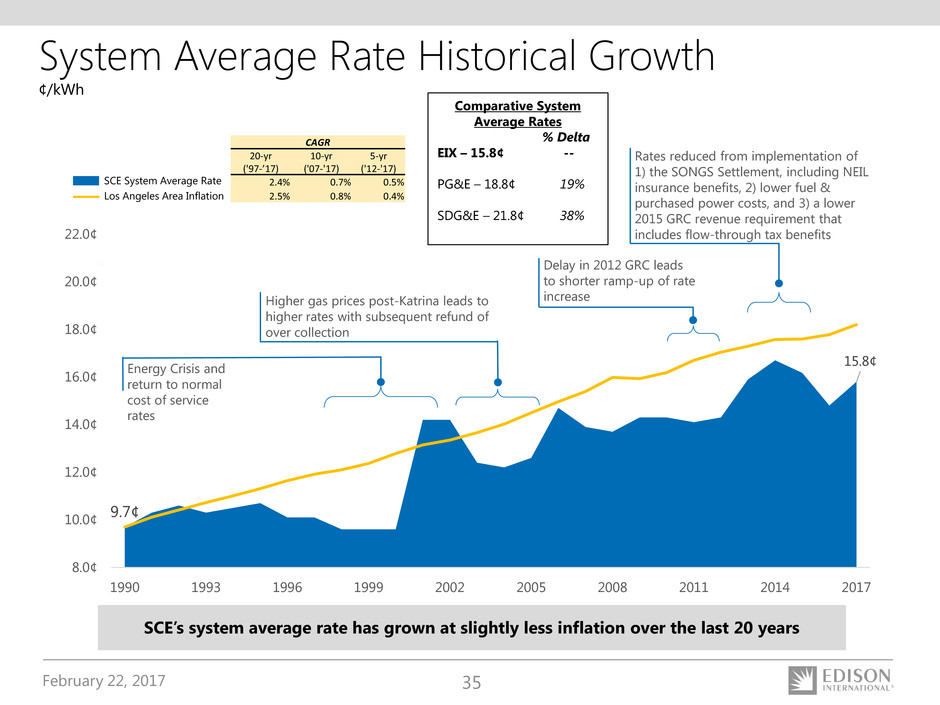
February 22, 2017 35
9.7¢
15.8¢
8.0¢
10.0¢
12.0¢
14.0¢
16.0¢
18.0¢
20.0¢
22.0¢
1990 1993 1996 1999 2002 2005 2008 2011 2014 2017
Energy Crisis and
return to normal
cost of service
rates
Higher gas prices post-Katrina leads to
higher rates with subsequent refund of
over collection
Delay in 2012 GRC leads
to shorter ramp-up of rate
increase
¢/kWh
Rates reduced from implementation of
1) the SONGS Settlement, including NEIL
insurance benefits, 2) lower fuel &
purchased power costs, and 3) a lower
2015 GRC revenue requirement that
includes flow-through tax benefits
System Average Rate Historical Growth
SCE’s system average rate has grown at slightly less inflation over the last 20 years
SCE System Average Rate
Los Angeles Area Inflation
Comparative System
Average Rates
% Delta
EIX – 15.8¢ --
PG&E – 18.8¢ 19%
SDG&E – 21.8¢ 38%
CAGR
20-yr
('97-’17)
10-yr
('07-'17)
5-yr
('12-'17)
2.4% 0.7% 0.5%
2.5% 0.8% 0.4%
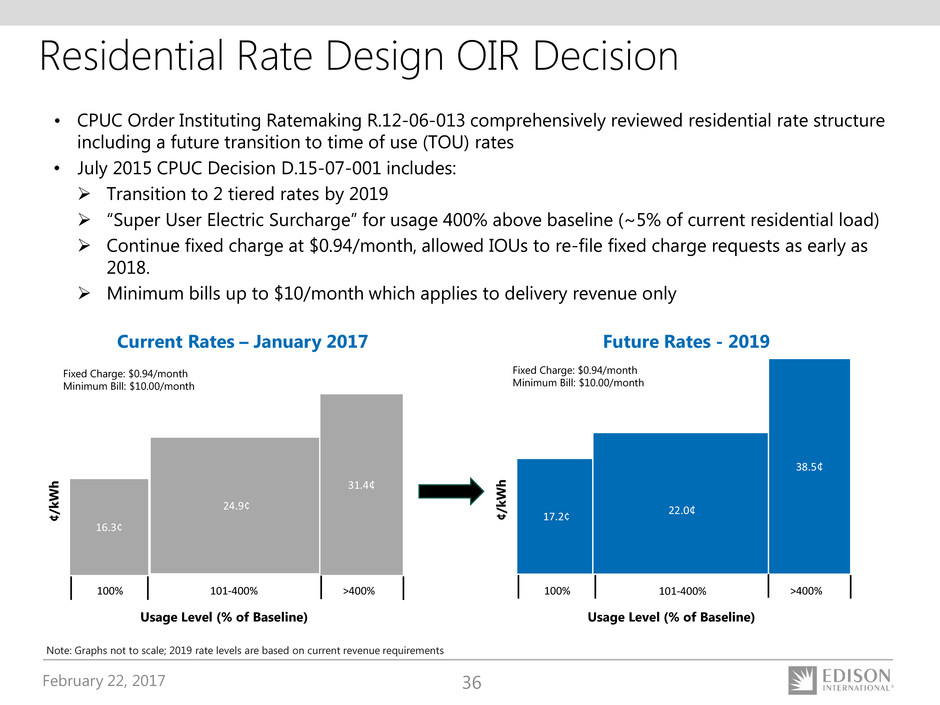
February 22, 2017 36
Residential Rate Design OIR Decision
• CPUC Order Instituting Ratemaking R.12-06-013 comprehensively reviewed residential rate structure
including a future transition to time of use (TOU) rates
• July 2015 CPUC Decision D.15-07-001 includes:
Transition to 2 tiered rates by 2019
“Super User Electric Surcharge” for usage 400% above baseline (~5% of current residential load)
Continue fixed charge at $0.94/month, allowed IOUs to re-file fixed charge requests as early as
2018.
Minimum bills up to $10/month which applies to delivery revenue only
Current Rates – January 2017 Future Rates - 2019
Fixed Charge: $0.94/month
Minimum Bill: $10.00/month
Note: Graphs not to scale; 2019 rate levels are based on current revenue requirements
17.2¢
38.5¢
100% 101-400% >400%
22.0¢
Usage Level (% of Baseline)
¢/
kW
h
Usage Level (% of Baseline)
16.3¢
24.9¢
31.4¢
100% 101-400% >400%
¢/
kW
h
Fixed Charge: $0.94/month
Minimum Bill: $10.00/month
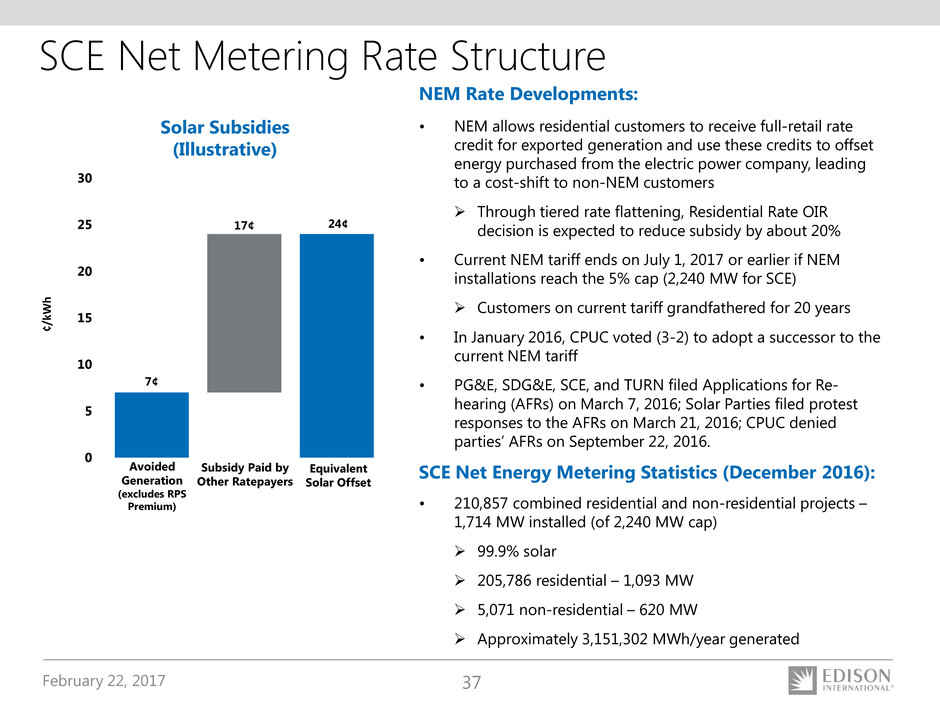
February 22, 2017 37
SCE Net Metering Rate Structure
7¢
24¢17¢
0
5
10
15
20
25
30
¢/
kW
h
Solar Subsidies
(Illustrative)
Avoided
Generation
(excludes RPS
Premium)
Subsidy Paid by
Other Ratepayers
Equivalent
Solar Offset
NEM Rate Developments:
• NEM allows residential customers to receive full-retail rate
credit for exported generation and use these credits to offset
energy purchased from the electric power company, leading
to a cost-shift to non-NEM customers
Through tiered rate flattening, Residential Rate OIR
decision is expected to reduce subsidy by about 20%
• Current NEM tariff ends on July 1, 2017 or earlier if NEM
installations reach the 5% cap (2,240 MW for SCE)
Customers on current tariff grandfathered for 20 years
• In January 2016, CPUC voted (3-2) to adopt a successor to the
current NEM tariff
• PG&E, SDG&E, SCE, and TURN filed Applications for Re-
hearing (AFRs) on March 7, 2016; Solar Parties filed protest
responses to the AFRs on March 21, 2016; CPUC denied
parties’ AFRs on September 22, 2016.
SCE Net Energy Metering Statistics (December 2016):
• 210,857 combined residential and non-residential projects –
1,714 MW installed (of 2,240 MW cap)
99.9% solar
205,786 residential – 1,093 MW
5,071 non-residential – 620 MW
Approximately 3,151,302 MWh/year generated
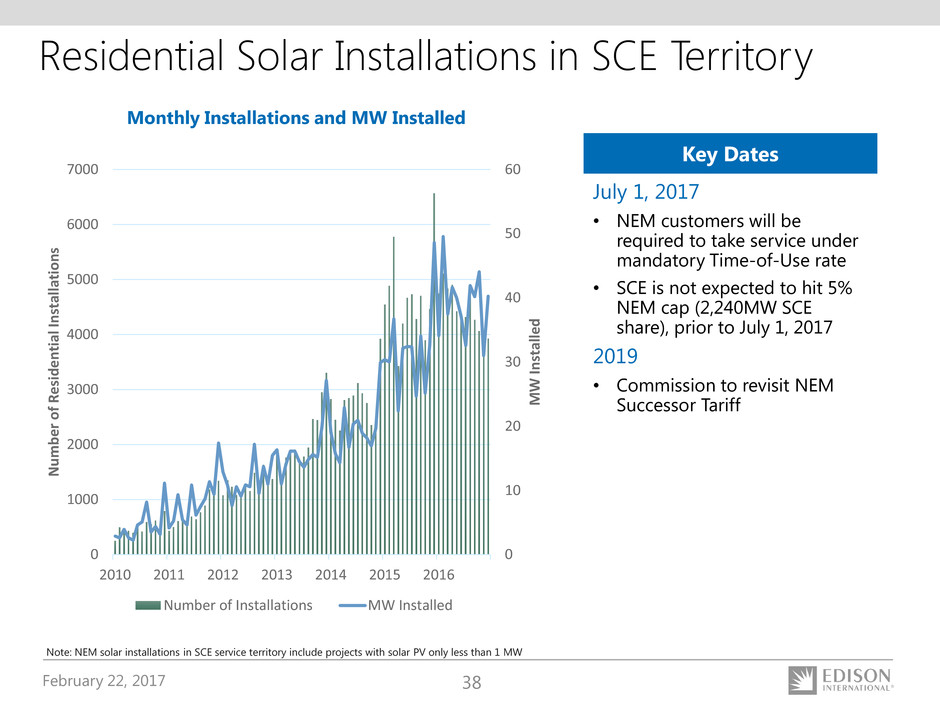
February 22, 2017 38
Note: NEM solar installations in SCE service territory include projects with solar PV only less than 1 MW
Residential Solar Installations in SCE Territory
July 1, 2017
• NEM customers will be
required to take service under
mandatory Time-of-Use rate
• SCE is not expected to hit 5%
NEM cap (2,240MW SCE
share), prior to July 1, 2017
2019
• Commission to revisit NEM
Successor Tariff
Key Dates
Monthly Installations and MW Installed
0
10
20
30
40
50
60
0
1000
2000
3000
4000
5000
6000
7000
2010 2011 2012 2013 2014 2015 2016
M
W
In
st
al
le
d
N
um
be
r
of
R
es
id
en
ti
al
In
st
al
la
ti
on
s
Number of Installations MW Installed
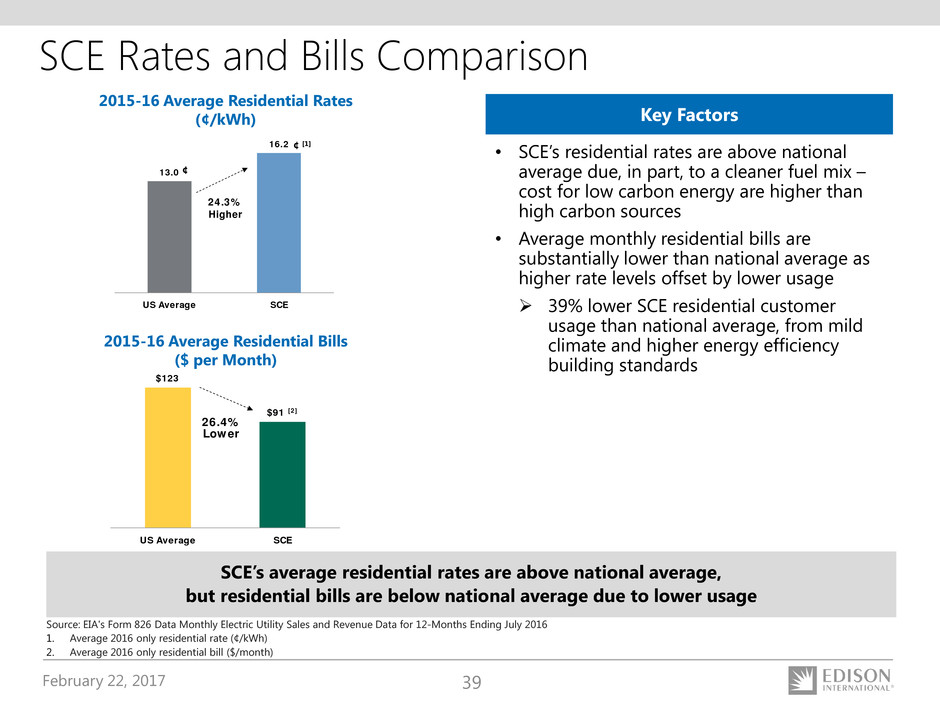
February 22, 2017 39
SCE Rates and Bills Comparison
SCE’s average residential rates are above national average,
but residential bills are below national average due to lower usage
• SCE’s residential rates are above national
average due, in part, to a cleaner fuel mix –
cost for low carbon energy are higher than
high carbon sources
• Average monthly residential bills are
substantially lower than national average as
higher rate levels offset by lower usage
39% lower SCE residential customer
usage than national average, from mild
climate and higher energy efficiency
building standards
Key FactorsKey Factors
Source: EIA's Form 826 Data Monthly Electric Utility Sales and Revenue Data for 12-Months Ending July 2016
1. Average 2016 only residential rate (¢/kWh)
2. Average 2016 only residential bill ($/month)
13.0
16.2
US Average SCE
24.3%
Higher
2015-16 Average Residential Rates
(¢/kWh)
2015-16 Average Residential Bills
($ per Month)
$123
$91 [2]
US Average SCE
26.4%
Lower
¢
¢ [1]
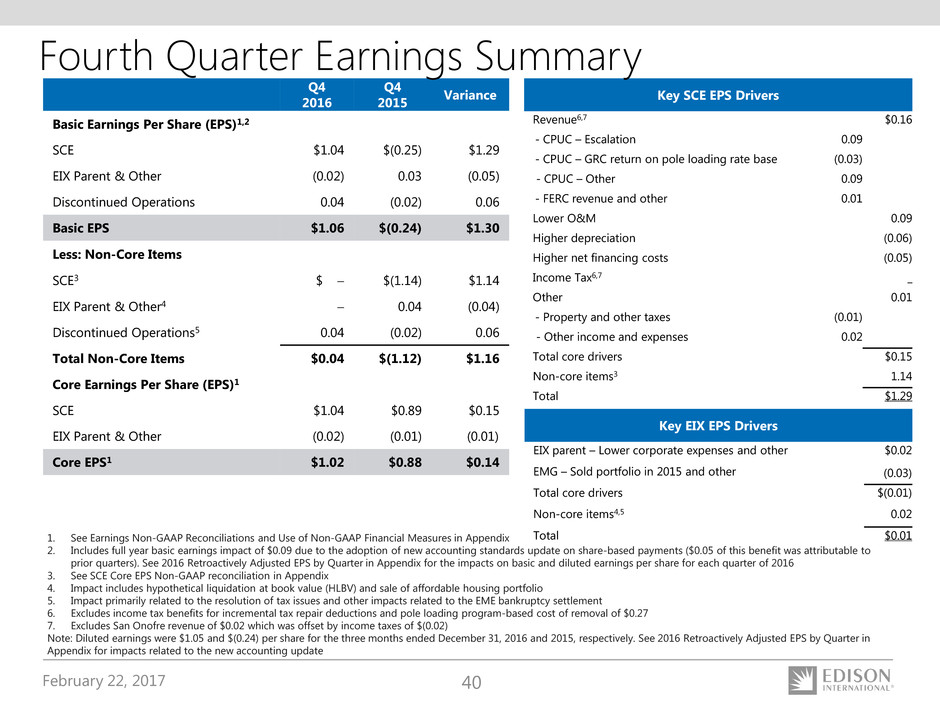
February 22, 2017 40
Q4
2016
Q4
2015
Variance
Basic Earnings Per Share (EPS)1,2
SCE $1.04 $(0.25) $1.29
EIX Parent & Other (0.02) 0.03 (0.05)
Discontinued Operations 0.04 (0.02) 0.06
Basic EPS $1.06 $(0.24) $1.30
Less: Non-Core Items
SCE3 $ − $(1.14) $1.14
EIX Parent & Other4 − 0.04 (0.04)
Discontinued Operations5 0.04 (0.02) 0.06
Total Non-Core Items $0.04 $(1.12) $1.16
Core Earnings Per Share (EPS)1
SCE $1.04 $0.89 $0.15
EIX Parent & Other (0.02) (0.01) (0.01)
Core EPS1 $1.02 $0.88 $0.14
Key SCE EPS Drivers
Revenue6,7 $0.16
- CPUC – Escalation 0.09
- CPUC – GRC return on pole loading rate base (0.03)
- CPUC – Other 0.09
- FERC revenue and other 0.01
Lower O&M 0.09
Higher depreciation (0.06)
Higher net financing costs (0.05)
Income Tax6,7 _
Other 0.01
- Property and other taxes (0.01)
- Other income and expenses 0.02
Total core drivers $0.15
Non-core items3 1.14
Total $1.29
Fourth Quarter Earnings Summary
Key EIX EPS Drivers
EIX parent – Lower corporate expenses and other $0.02
EMG – Sold portfolio in 2015 and other (0.03)
Total core drivers $(0.01)
Non-core items4,5 0.02
Total $0.011. See Earnings Non-GAAP Reconciliations and Use of Non-GAAP Financial Measures in Appendix
2. Includes full year basic earnings impact of $0.09 due to the adoption of new accounting standards update on share-based payments ($0.05 of this benefit was attributable to
prior quarters). See 2016 Retroactively Adjusted EPS by Quarter in Appendix for the impacts on basic and diluted earnings per share for each quarter of 2016
3. See SCE Core EPS Non-GAAP reconciliation in Appendix
4. Impact includes hypothetical liquidation at book value (HLBV) and sale of affordable housing portfolio
5. Impact primarily related to the resolution of tax issues and other impacts related to the EME bankruptcy settlement
6. Excludes income tax benefits for incremental tax repair deductions and pole loading program-based cost of removal of $0.27
7. Excludes San Onofre revenue of $0.02 which was offset by income taxes of $(0.02)
Note: Diluted earnings were $1.05 and $(0.24) per share for the three months ended December 31, 2016 and 2015, respectively. See 2016 Retroactively Adjusted EPS by Quarter in
Appendix for impacts related to the new accounting update
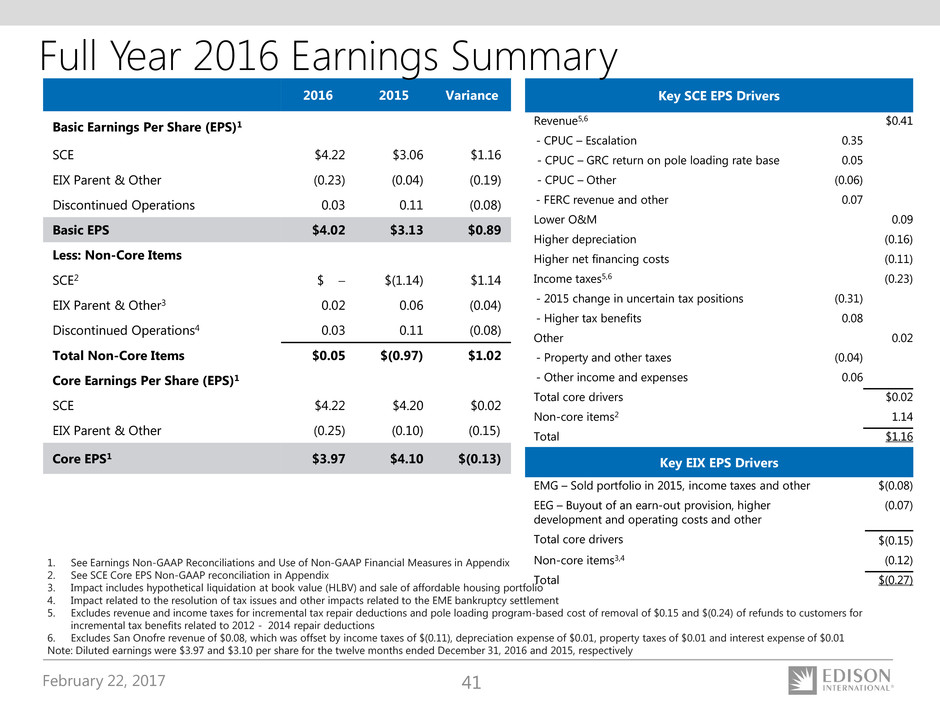
February 22, 2017 41
2016 2015 Variance
Basic Earnings Per Share (EPS)1
SCE $4.22 $3.06 $1.16
EIX Parent & Other (0.23) (0.04) (0.19)
Discontinued Operations 0.03 0.11 (0.08)
Basic EPS $4.02 $3.13 $0.89
Less: Non-Core Items
SCE2 $ − $(1.14) $1.14
EIX Parent & Other3 0.02 0.06 (0.04)
Discontinued Operations4 0.03 0.11 (0.08)
Total Non-Core Items $0.05 $(0.97) $1.02
Core Earnings Per Share (EPS)1
SCE $4.22 $4.20 $0.02
EIX Parent & Other (0.25) (0.10) (0.15)
Core EPS1 $3.97 $4.10 $(0.13)
Key SCE EPS Drivers
Revenue5,6 $0.41
- CPUC – Escalation 0.35
- CPUC – GRC return on pole loading rate base 0.05
- CPUC – Other (0.06)
- FERC revenue and other 0.07
Lower O&M 0.09
Higher depreciation (0.16)
Higher net financing costs (0.11)
Income taxes5,6 (0.23)
- 2015 change in uncertain tax positions (0.31)
- Higher tax benefits 0.08
Other 0.02
- Property and other taxes (0.04)
- Other income and expenses 0.06
Total core drivers $0.02
Non-core items2 1.14
Total $1.16
Full Year 2016 Earnings Summary
Key EIX EPS Drivers
EMG – Sold portfolio in 2015, income taxes and other $(0.08)
EEG – Buyout of an earn-out provision, higher
development and operating costs and other
(0.07)
Total core drivers $(0.15)
Non-core items3,4 (0.12)
Total $(0.27)
1. See Earnings Non-GAAP Reconciliations and Use of Non-GAAP Financial Measures in Appendix
2. See SCE Core EPS Non-GAAP reconciliation in Appendix
3. Impact includes hypothetical liquidation at book value (HLBV) and sale of affordable housing portfolio
4. Impact related to the resolution of tax issues and other impacts related to the EME bankruptcy settlement
5. Excludes revenue and income taxes for incremental tax repair deductions and pole loading program-based cost of removal of $0.15 and $(0.24) of refunds to customers for
incremental tax benefits related to 2012 - 2014 repair deductions
6. Excludes San Onofre revenue of $0.08, which was offset by income taxes of $(0.11), depreciation expense of $0.01, property taxes of $0.01 and interest expense of $0.01
Note: Diluted earnings were $3.97 and $3.10 per share for the twelve months ended December 31, 2016 and 2015, respectively
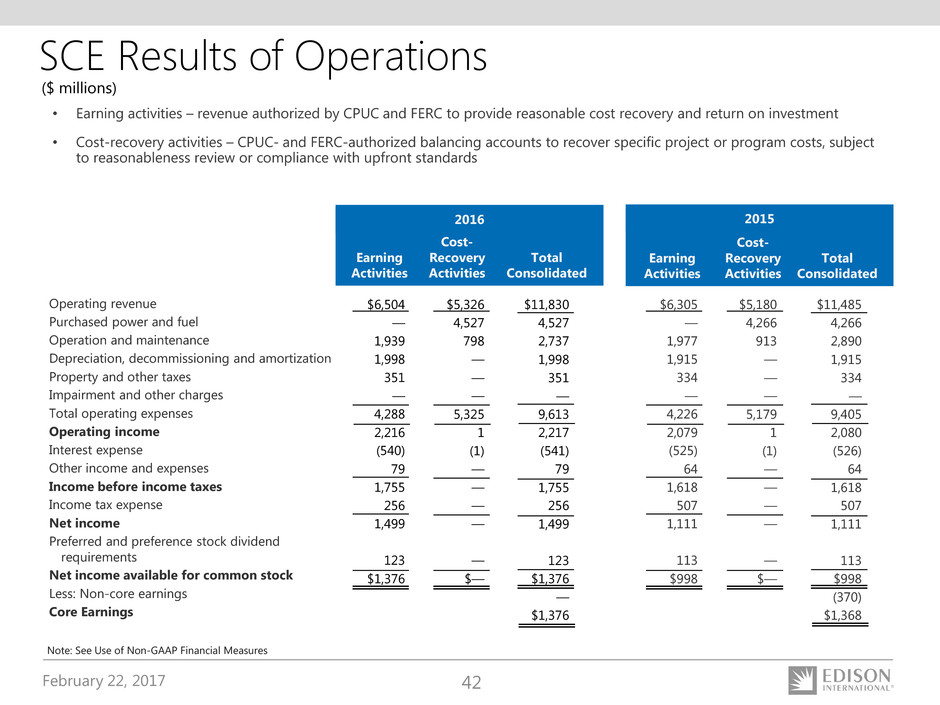
February 22, 2017 42
$6,305
—
1,977
1,915
334
—
4,226
2,079
(525)
64
1,618
507
1,111
113
$998
$5,180
4,266
913
—
—
—
5,179
1
(1)
—
—
—
—
—
$—
$11,485
4,266
2,890
1,915
334
—
9,405
2,080
(526)
64
1,618
507
1,111
113
$998
(370)
$1,368
SCE Results of Operations
• Earning activities – revenue authorized by CPUC and FERC to provide reasonable cost recovery and return on investment
• Cost-recovery activities – CPUC- and FERC-authorized balancing accounts to recover specific project or program costs, subject
to reasonableness review or compliance with upfront standards
Earning
Activities
Cost-
Recovery
Activities
Total
Consolidated
2016
Earning
Activities
Cost-
Recovery
Activities
Total
Consolidated
2015
Operating revenue
Purchased power and fuel
Operation and maintenance
Depreciation, decommissioning and amortization
Property and other taxes
Impairment and other charges
Total operating expenses
Operating income
Interest expense
Other income and expenses
Income before income taxes
Income tax expense
Net income
Preferred and preference stock dividend
requirements
Net income available for common stock
Less: Non-core earnings
Core Earnings
Note: See Use of Non-GAAP Financial Measures
($ millions)
$6,504
—
1,939
1,998
351
—
4,288
2,216
(540)
79
1,755
256
1,499
123
$1,376
$5,326
4,527
798
—
—
—
5,325
1
(1)
—
—
—
—
—
$—
$11,830
4,527
2,737
1,998
351
—
9,613
2,217
(541)
79
1,755
256
1,499
123
$1,376
—
$1,376
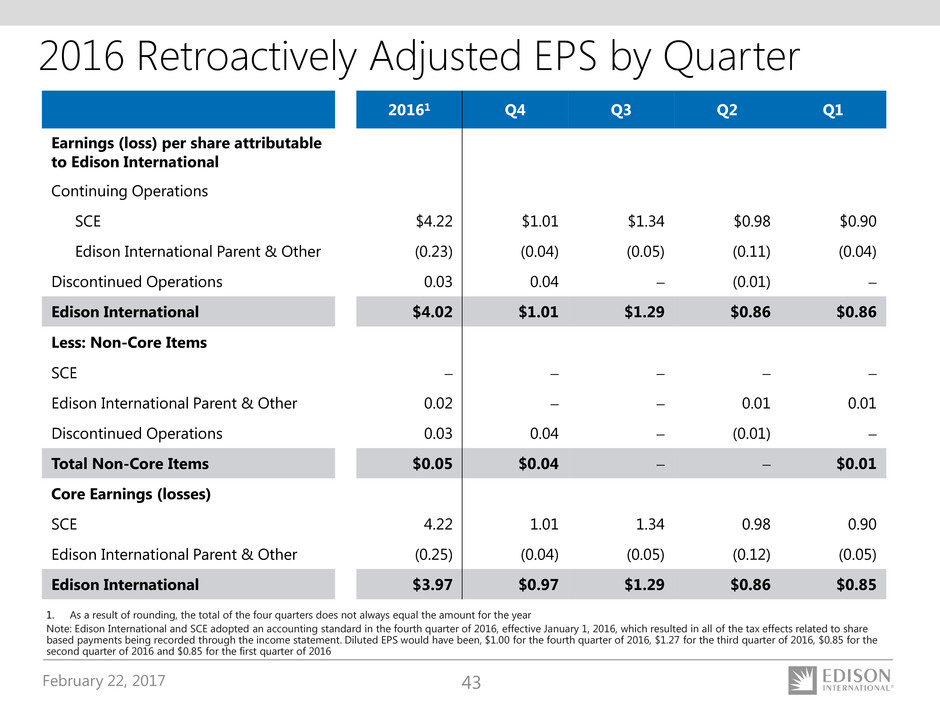
February 22, 2017 43
2016 Retroactively Adjusted EPS by Quarter
20161 Q4 Q3 Q2 Q1
Earnings (loss) per share attributable
to Edison International
Continuing Operations
SCE $4.22 $1.01 $1.34 $0.98 $0.90
Edison International Parent & Other (0.23) (0.04) (0.05) (0.11) (0.04)
Discontinued Operations 0.03 0.04 − (0.01) −
Edison International $4.02 $1.01 $1.29 $0.86 $0.86
Less: Non-Core Items
SCE − − − − −
Edison International Parent & Other 0.02 − − 0.01 0.01
Discontinued Operations 0.03 0.04 − (0.01) −
Total Non-Core Items $0.05 $0.04 − − $0.01
Core Earnings (losses)
SCE 4.22 1.01 1.34 0.98 0.90
Edison International Parent & Other (0.25) (0.04) (0.05) (0.12) (0.05)
Edison International $3.97 $0.97 $1.29 $0.86 $0.85
1. As a result of rounding, the total of the four quarters does not always equal the amount for the year
Note: Edison International and SCE adopted an accounting standard in the fourth quarter of 2016, effective January 1, 2016, which resulted in all of the tax effects related to share
based payments being recorded through the income statement. Diluted EPS would have been, $1.00 for the fourth quarter of 2016, $1.27 for the third quarter of 2016, $0.85 for the
second quarter of 2016 and $0.85 for the first quarter of 2016
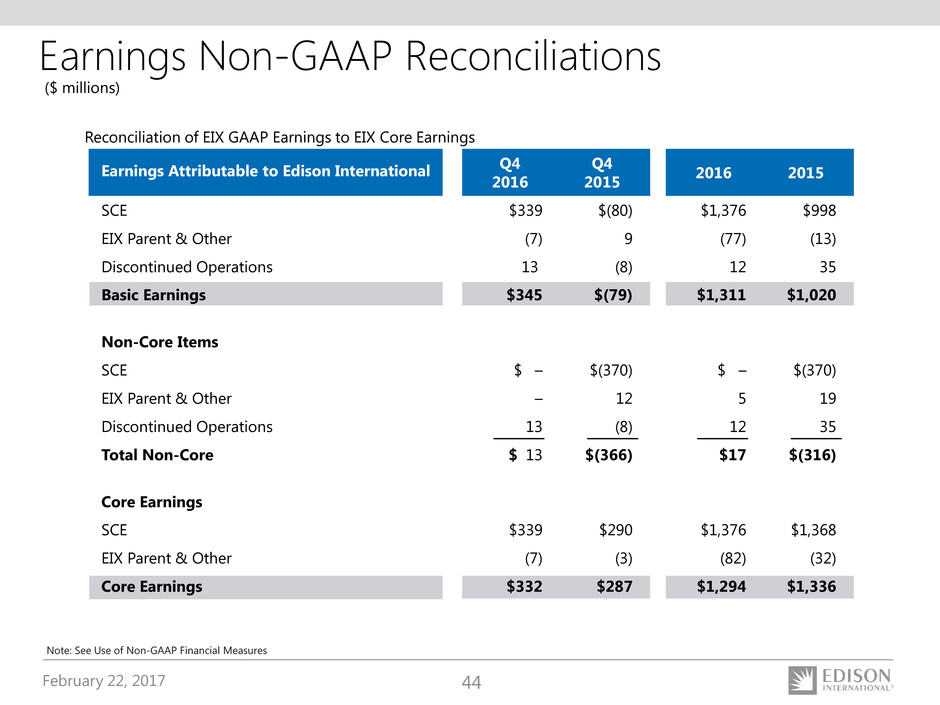
February 22, 2017 44
Earnings Non-GAAP Reconciliations
Note: See Use of Non-GAAP Financial Measures
($ millions)
Reconciliation of EIX GAAP Earnings to EIX Core Earnings
SCE
EIX Parent & Other
Discontinued Operations
Basic Earnings
Non-Core Items
SCE
EIX Parent & Other
Discontinued Operations
Total Non-Core
Core Earnings
SCE
EIX Parent & Other
Core Earnings
$(80)
9
(8)
$(79)
$(370)
12
(8)
$(366)
$290
(3)
$287
$339
(7)
13
$345
$ –
–
13
$ 13
$339
(7)
$332
Q4
2015
Q4
2016
Earnings Attributable to Edison International
$998
(13)
35
$1,020
$(370)
19
35
$(316)
$1,368
(32)
$1,336
$1,376
(77)
12
$1,311
$ –
5
12
$17
$1,376
(82)
$1,294
20152016
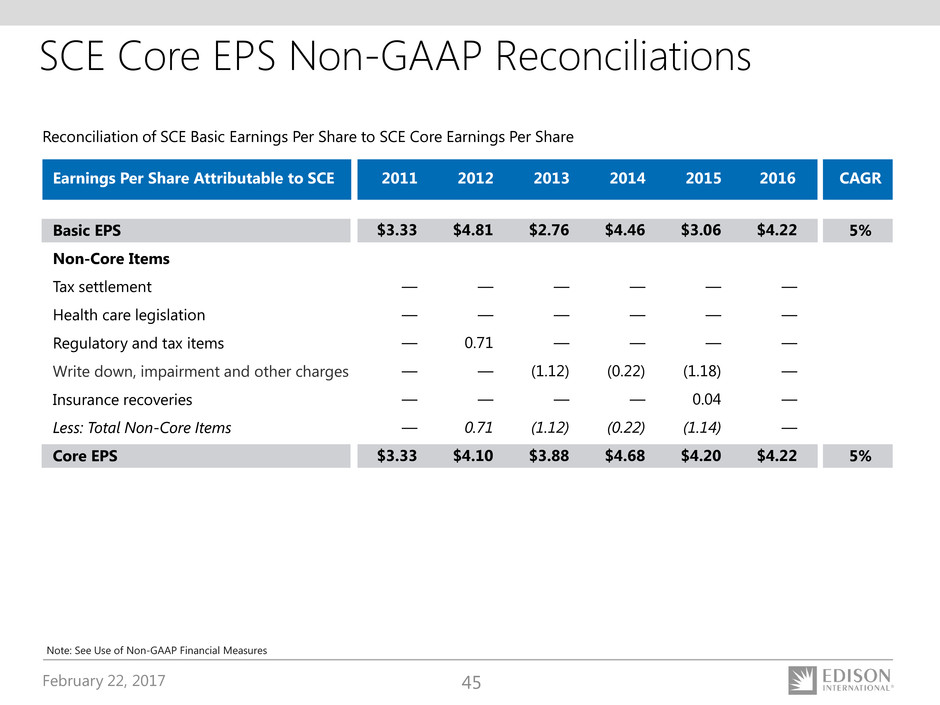
February 22, 2017 45
SCE Core EPS Non-GAAP Reconciliations
Basic EPS
Non-Core Items
Tax settlement
Health care legislation
Regulatory and tax items
Write down, impairment and other charges
Insurance recoveries
Less: Total Non-Core Items
Core EPS
Reconciliation of SCE Basic Earnings Per Share to SCE Core Earnings Per Share
5%
5%
$3.33
—
—
—
—
—
—
$3.33
$4.81
—
—
0.71
—
—
0.71
$4.10
$2.76
—
—
—
(1.12)
—
(1.12)
$3.88
Note: See Use of Non-GAAP Financial Measures
$4.46
—
—
—
(0.22)
—
(0.22)
$4.68
$3.06
—
—
—
(1.18)
0.04
(1.14)
$4.20
Earnings Per Share Attributable to SCE CAGR2011 2012 2013 2014 2015
$4.22
—
—
—
—
—
—
$4.22
2016

February 22, 2017 46
Use of Non-GAAP Financial Measures
Edison International's earnings are prepared in accordance with generally accepted
accounting principles used in the United States. Management uses core earnings internally
for financial planning and for analysis of performance. Core earnings are also used when
communicating with investors and analysts regarding Edison International's earnings results
to facilitate comparisons of the Company's performance from period to period. Core
earnings are a non-GAAP financial measure and may not be comparable to those of other
companies. Core earnings (or losses) are defined as earnings or losses attributable to Edison
International shareholders less income or loss from discontinued operations and income or
loss from significant discrete items that management does not consider representative of
ongoing earnings, such as: exit activities, including sale of certain assets, and other activities
that are no longer continuing; asset impairments and certain tax, regulatory or legal
settlements or proceedings.
A reconciliation of Non-GAAP information to GAAP information is included either on the
slide where the information appears or on another slide referenced in this presentation.
EIX Investor Relations Contact
Scott Cunningham, Vice President (626) 302-2540 scott.cunningham@edisonintl.com
Allison Bahen, Senior Manager (626) 302-5493 allison.bahen@edisonintl.com

